Comprehensive Report: Reduced Physical Activity in Nursing Population
VerifiedAdded on 2021/06/05
|21
|4878
|27
Report
AI Summary
This report delves into the significant issue of reduced physical activity within the nursing population, highlighting its implications for both individual nurses and public health. The report begins by establishing the problem's background, referencing data from the CDC on the importance of physical act...
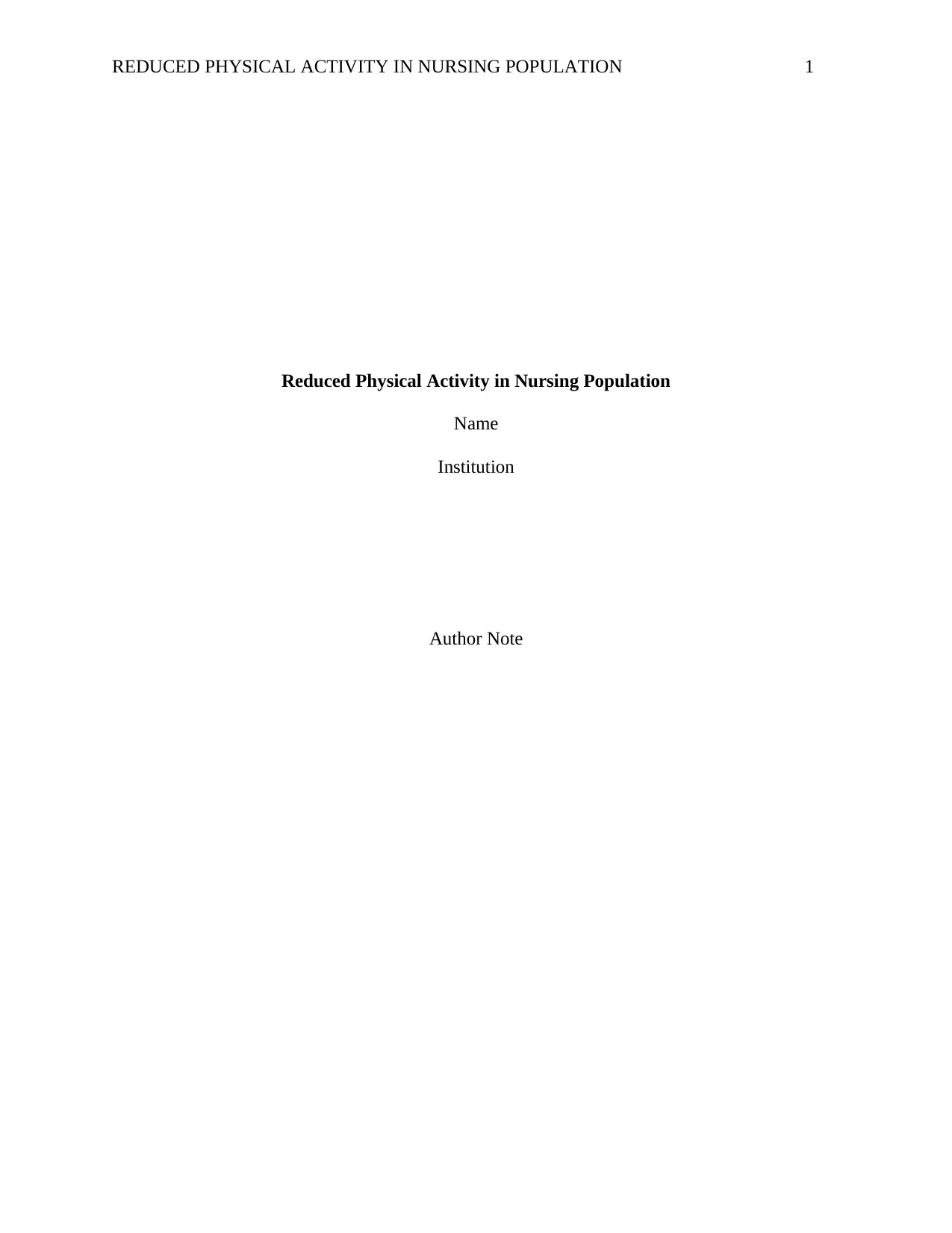
REDUCED PHYSICAL ACTIVITY IN NURSING POPULATION 1
Reduced Physical Activity in Nursing Population
Name
Institution
Author Note
Reduced Physical Activity in Nursing Population
Name
Institution
Author Note
Paraphrase This Document
Need a fresh take? Get an instant paraphrase of this document with our AI Paraphraser
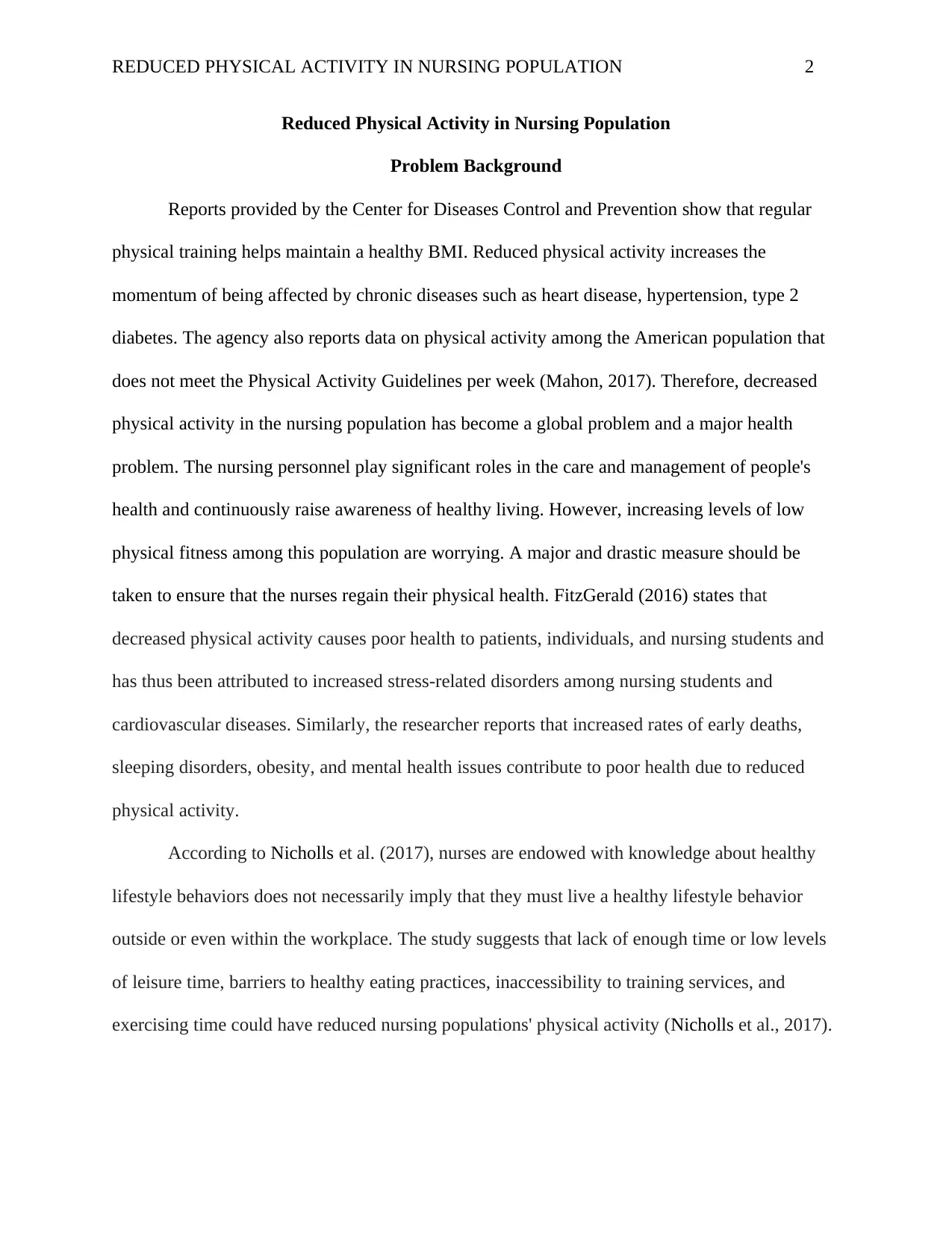
REDUCED PHYSICAL ACTIVITY IN NURSING POPULATION 2
Reduced Physical Activity in Nursing Population
Problem Background
Reports provided by the Center for Diseases Control and Prevention show that regular
physical training helps maintain a healthy BMI. Reduced physical activity increases the
momentum of being affected by chronic diseases such as heart disease, hypertension, type 2
diabetes. The agency also reports data on physical activity among the American population that
does not meet the Physical Activity Guidelines per week (Mahon, 2017). Therefore, decreased
physical activity in the nursing population has become a global problem and a major health
problem. The nursing personnel play significant roles in the care and management of people's
health and continuously raise awareness of healthy living. However, increasing levels of low
physical fitness among this population are worrying. A major and drastic measure should be
taken to ensure that the nurses regain their physical health. FitzGerald (2016) states that
decreased physical activity causes poor health to patients, individuals, and nursing students and
has thus been attributed to increased stress-related disorders among nursing students and
cardiovascular diseases. Similarly, the researcher reports that increased rates of early deaths,
sleeping disorders, obesity, and mental health issues contribute to poor health due to reduced
physical activity.
According to Nicholls et al. (2017), nurses are endowed with knowledge about healthy
lifestyle behaviors does not necessarily imply that they must live a healthy lifestyle behavior
outside or even within the workplace. The study suggests that lack of enough time or low levels
of leisure time, barriers to healthy eating practices, inaccessibility to training services, and
exercising time could have reduced nursing populations' physical activity (Nicholls et al., 2017).
Reduced Physical Activity in Nursing Population
Problem Background
Reports provided by the Center for Diseases Control and Prevention show that regular
physical training helps maintain a healthy BMI. Reduced physical activity increases the
momentum of being affected by chronic diseases such as heart disease, hypertension, type 2
diabetes. The agency also reports data on physical activity among the American population that
does not meet the Physical Activity Guidelines per week (Mahon, 2017). Therefore, decreased
physical activity in the nursing population has become a global problem and a major health
problem. The nursing personnel play significant roles in the care and management of people's
health and continuously raise awareness of healthy living. However, increasing levels of low
physical fitness among this population are worrying. A major and drastic measure should be
taken to ensure that the nurses regain their physical health. FitzGerald (2016) states that
decreased physical activity causes poor health to patients, individuals, and nursing students and
has thus been attributed to increased stress-related disorders among nursing students and
cardiovascular diseases. Similarly, the researcher reports that increased rates of early deaths,
sleeping disorders, obesity, and mental health issues contribute to poor health due to reduced
physical activity.
According to Nicholls et al. (2017), nurses are endowed with knowledge about healthy
lifestyle behaviors does not necessarily imply that they must live a healthy lifestyle behavior
outside or even within the workplace. The study suggests that lack of enough time or low levels
of leisure time, barriers to healthy eating practices, inaccessibility to training services, and
exercising time could have reduced nursing populations' physical activity (Nicholls et al., 2017).
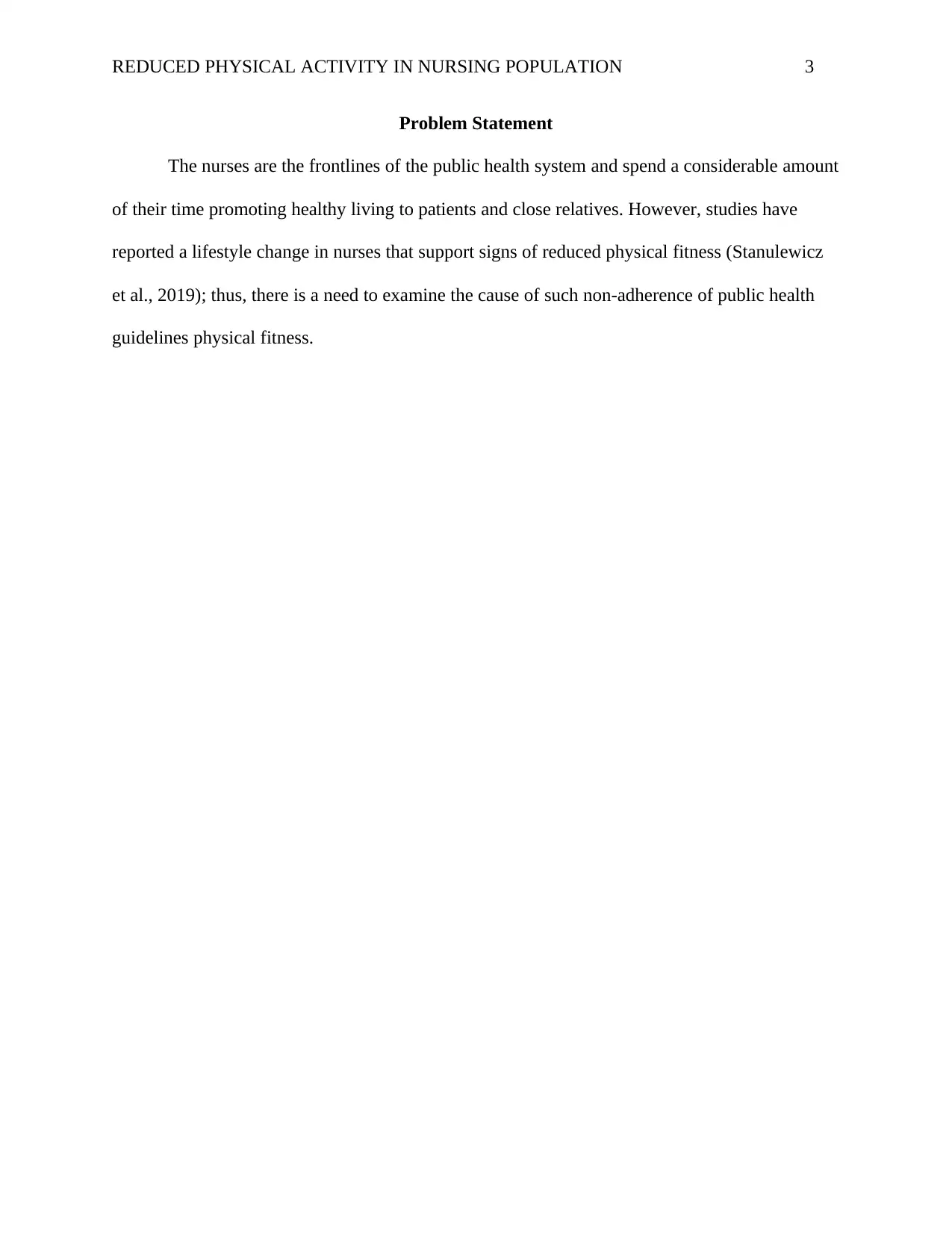
REDUCED PHYSICAL ACTIVITY IN NURSING POPULATION 3
Problem Statement
The nurses are the frontlines of the public health system and spend a considerable amount
of their time promoting healthy living to patients and close relatives. However, studies have
reported a lifestyle change in nurses that support signs of reduced physical fitness (Stanulewicz
et al., 2019); thus, there is a need to examine the cause of such non-adherence of public health
guidelines physical fitness.
Problem Statement
The nurses are the frontlines of the public health system and spend a considerable amount
of their time promoting healthy living to patients and close relatives. However, studies have
reported a lifestyle change in nurses that support signs of reduced physical fitness (Stanulewicz
et al., 2019); thus, there is a need to examine the cause of such non-adherence of public health
guidelines physical fitness.
You're viewing a preview
Unlock full access by subscribing today!
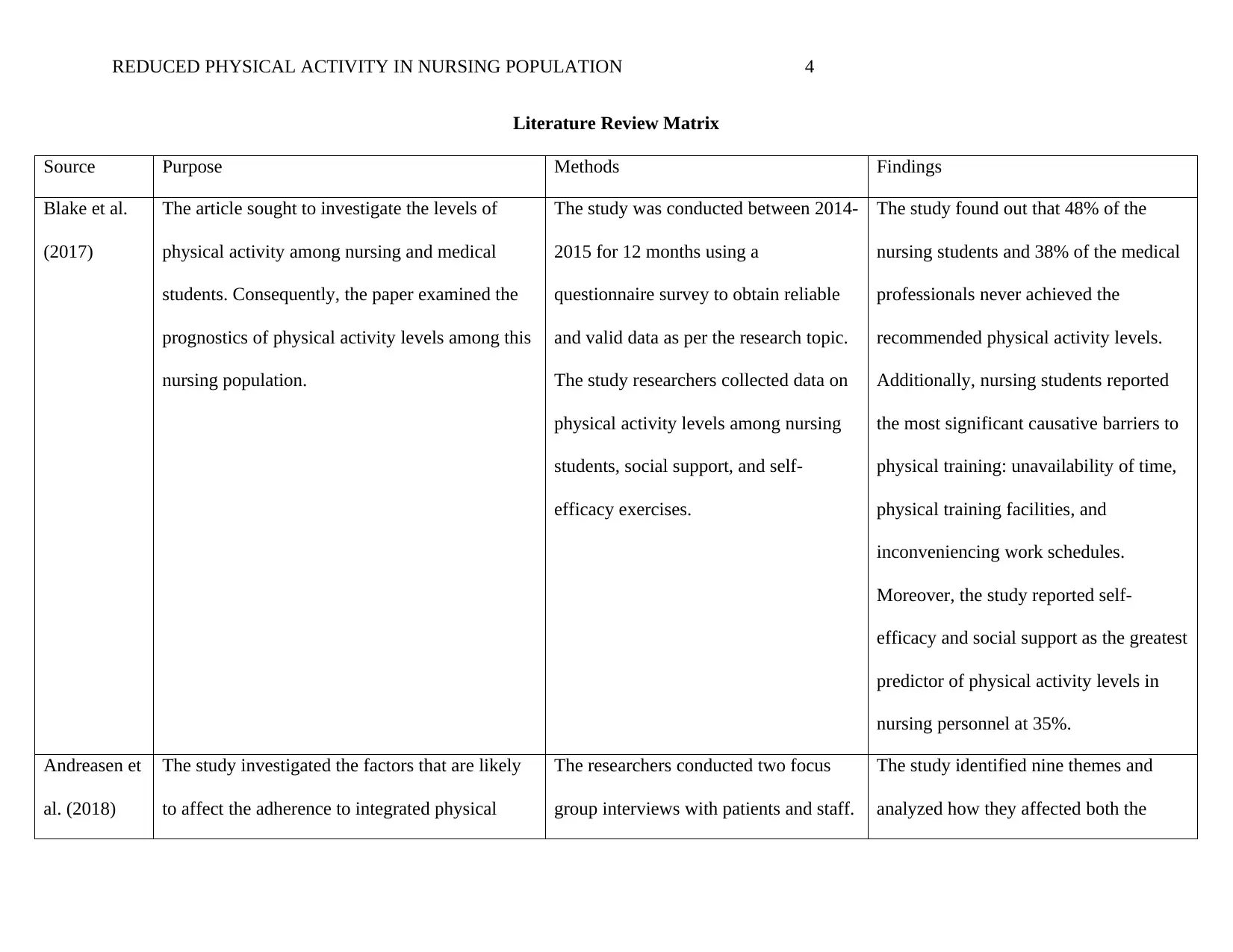
REDUCED PHYSICAL ACTIVITY IN NURSING POPULATION 4
Literature Review Matrix
Source Purpose Methods Findings
Blake et al.
(2017)
The article sought to investigate the levels of
physical activity among nursing and medical
students. Consequently, the paper examined the
prognostics of physical activity levels among this
nursing population.
The study was conducted between 2014-
2015 for 12 months using a
questionnaire survey to obtain reliable
and valid data as per the research topic.
The study researchers collected data on
physical activity levels among nursing
students, social support, and self-
efficacy exercises.
The study found out that 48% of the
nursing students and 38% of the medical
professionals never achieved the
recommended physical activity levels.
Additionally, nursing students reported
the most significant causative barriers to
physical training: unavailability of time,
physical training facilities, and
inconveniencing work schedules.
Moreover, the study reported self-
efficacy and social support as the greatest
predictor of physical activity levels in
nursing personnel at 35%.
Andreasen et
al. (2018)
The study investigated the factors that are likely
to affect the adherence to integrated physical
The researchers conducted two focus
group interviews with patients and staff.
The study identified nine themes and
analyzed how they affected both the
Literature Review Matrix
Source Purpose Methods Findings
Blake et al.
(2017)
The article sought to investigate the levels of
physical activity among nursing and medical
students. Consequently, the paper examined the
prognostics of physical activity levels among this
nursing population.
The study was conducted between 2014-
2015 for 12 months using a
questionnaire survey to obtain reliable
and valid data as per the research topic.
The study researchers collected data on
physical activity levels among nursing
students, social support, and self-
efficacy exercises.
The study found out that 48% of the
nursing students and 38% of the medical
professionals never achieved the
recommended physical activity levels.
Additionally, nursing students reported
the most significant causative barriers to
physical training: unavailability of time,
physical training facilities, and
inconveniencing work schedules.
Moreover, the study reported self-
efficacy and social support as the greatest
predictor of physical activity levels in
nursing personnel at 35%.
Andreasen et
al. (2018)
The study investigated the factors that are likely
to affect the adherence to integrated physical
The researchers conducted two focus
group interviews with patients and staff.
The study identified nine themes and
analyzed how they affected both the
Paraphrase This Document
Need a fresh take? Get an instant paraphrase of this document with our AI Paraphraser
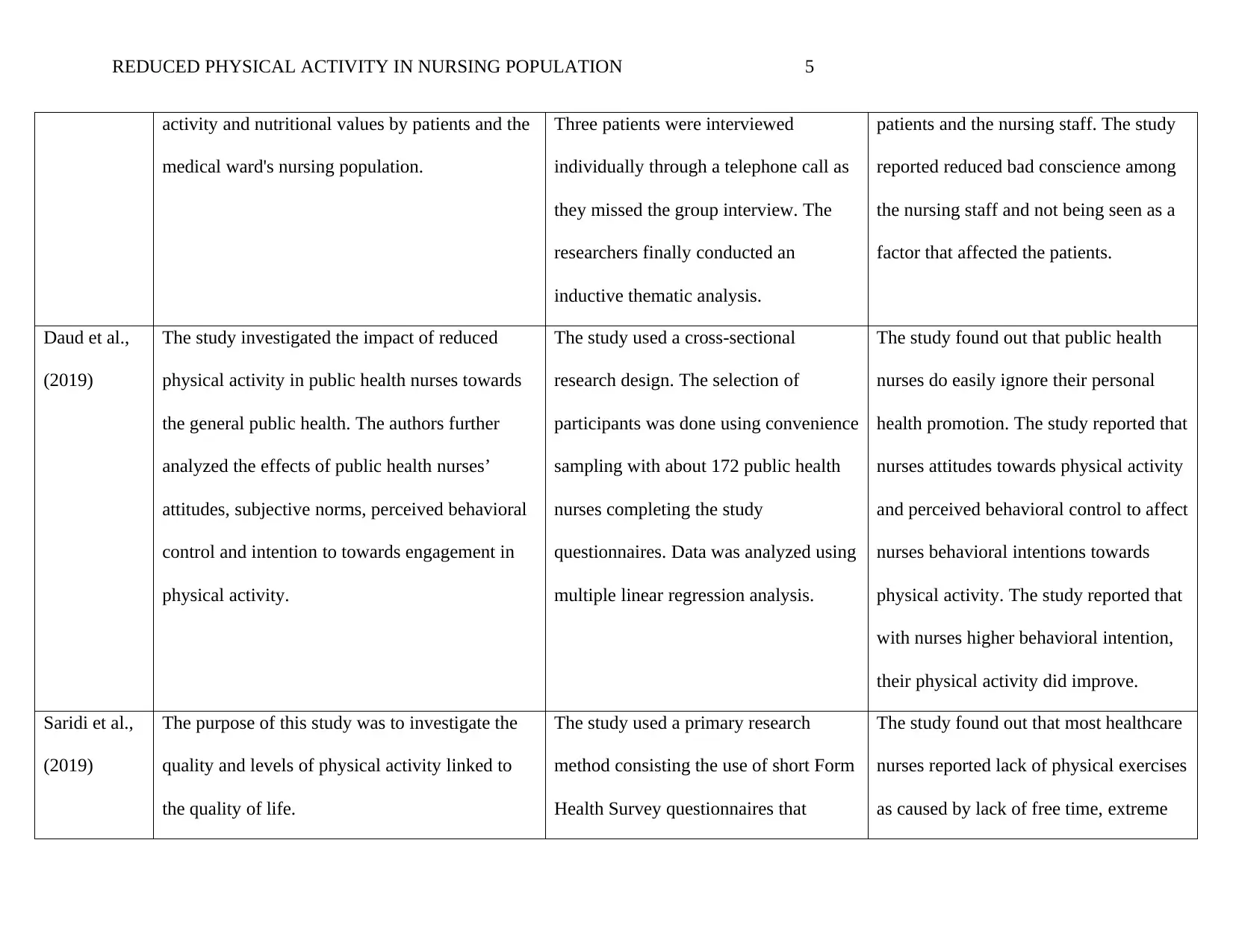
REDUCED PHYSICAL ACTIVITY IN NURSING POPULATION 5
activity and nutritional values by patients and the
medical ward's nursing population.
Three patients were interviewed
individually through a telephone call as
they missed the group interview. The
researchers finally conducted an
inductive thematic analysis.
patients and the nursing staff. The study
reported reduced bad conscience among
the nursing staff and not being seen as a
factor that affected the patients.
Daud et al.,
(2019)
The study investigated the impact of reduced
physical activity in public health nurses towards
the general public health. The authors further
analyzed the effects of public health nurses’
attitudes, subjective norms, perceived behavioral
control and intention to towards engagement in
physical activity.
The study used a cross-sectional
research design. The selection of
participants was done using convenience
sampling with about 172 public health
nurses completing the study
questionnaires. Data was analyzed using
multiple linear regression analysis.
The study found out that public health
nurses do easily ignore their personal
health promotion. The study reported that
nurses attitudes towards physical activity
and perceived behavioral control to affect
nurses behavioral intentions towards
physical activity. The study reported that
with nurses higher behavioral intention,
their physical activity did improve.
Saridi et al.,
(2019)
The purpose of this study was to investigate the
quality and levels of physical activity linked to
the quality of life.
The study used a primary research
method consisting the use of short Form
Health Survey questionnaires that
The study found out that most healthcare
nurses reported lack of physical exercises
as caused by lack of free time, extreme
activity and nutritional values by patients and the
medical ward's nursing population.
Three patients were interviewed
individually through a telephone call as
they missed the group interview. The
researchers finally conducted an
inductive thematic analysis.
patients and the nursing staff. The study
reported reduced bad conscience among
the nursing staff and not being seen as a
factor that affected the patients.
Daud et al.,
(2019)
The study investigated the impact of reduced
physical activity in public health nurses towards
the general public health. The authors further
analyzed the effects of public health nurses’
attitudes, subjective norms, perceived behavioral
control and intention to towards engagement in
physical activity.
The study used a cross-sectional
research design. The selection of
participants was done using convenience
sampling with about 172 public health
nurses completing the study
questionnaires. Data was analyzed using
multiple linear regression analysis.
The study found out that public health
nurses do easily ignore their personal
health promotion. The study reported that
nurses attitudes towards physical activity
and perceived behavioral control to affect
nurses behavioral intentions towards
physical activity. The study reported that
with nurses higher behavioral intention,
their physical activity did improve.
Saridi et al.,
(2019)
The purpose of this study was to investigate the
quality and levels of physical activity linked to
the quality of life.
The study used a primary research
method consisting the use of short Form
Health Survey questionnaires that
The study found out that most healthcare
nurses reported lack of physical exercises
as caused by lack of free time, extreme
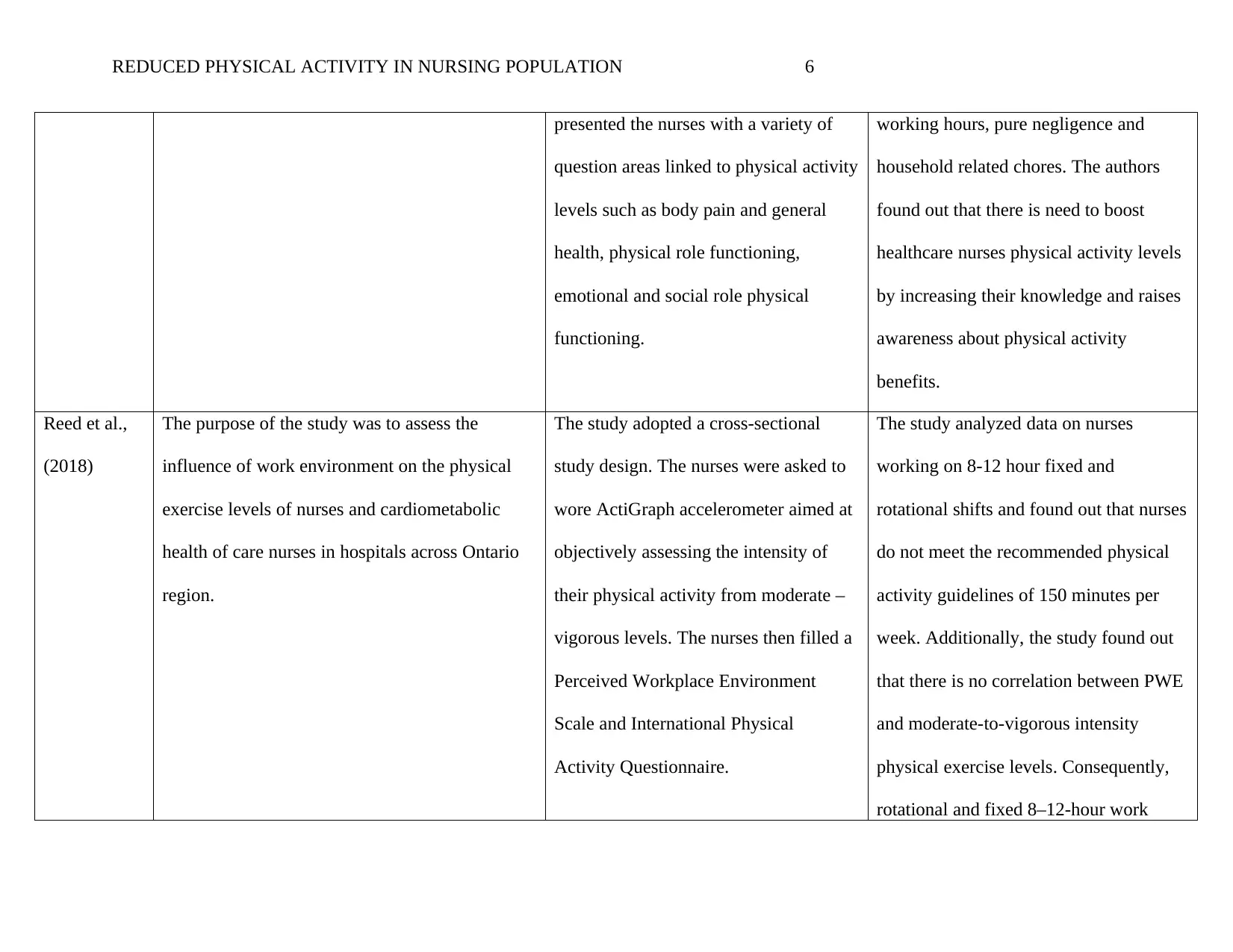
REDUCED PHYSICAL ACTIVITY IN NURSING POPULATION 6
presented the nurses with a variety of
question areas linked to physical activity
levels such as body pain and general
health, physical role functioning,
emotional and social role physical
functioning.
working hours, pure negligence and
household related chores. The authors
found out that there is need to boost
healthcare nurses physical activity levels
by increasing their knowledge and raises
awareness about physical activity
benefits.
Reed et al.,
(2018)
The purpose of the study was to assess the
influence of work environment on the physical
exercise levels of nurses and cardiometabolic
health of care nurses in hospitals across Ontario
region.
The study adopted a cross-sectional
study design. The nurses were asked to
wore ActiGraph accelerometer aimed at
objectively assessing the intensity of
their physical activity from moderate –
vigorous levels. The nurses then filled a
Perceived Workplace Environment
Scale and International Physical
Activity Questionnaire.
The study analyzed data on nurses
working on 8-12 hour fixed and
rotational shifts and found out that nurses
do not meet the recommended physical
activity guidelines of 150 minutes per
week. Additionally, the study found out
that there is no correlation between PWE
and moderate-to-vigorous intensity
physical exercise levels. Consequently,
rotational and fixed 8–12-hour work
presented the nurses with a variety of
question areas linked to physical activity
levels such as body pain and general
health, physical role functioning,
emotional and social role physical
functioning.
working hours, pure negligence and
household related chores. The authors
found out that there is need to boost
healthcare nurses physical activity levels
by increasing their knowledge and raises
awareness about physical activity
benefits.
Reed et al.,
(2018)
The purpose of the study was to assess the
influence of work environment on the physical
exercise levels of nurses and cardiometabolic
health of care nurses in hospitals across Ontario
region.
The study adopted a cross-sectional
study design. The nurses were asked to
wore ActiGraph accelerometer aimed at
objectively assessing the intensity of
their physical activity from moderate –
vigorous levels. The nurses then filled a
Perceived Workplace Environment
Scale and International Physical
Activity Questionnaire.
The study analyzed data on nurses
working on 8-12 hour fixed and
rotational shifts and found out that nurses
do not meet the recommended physical
activity guidelines of 150 minutes per
week. Additionally, the study found out
that there is no correlation between PWE
and moderate-to-vigorous intensity
physical exercise levels. Consequently,
rotational and fixed 8–12-hour work
You're viewing a preview
Unlock full access by subscribing today!
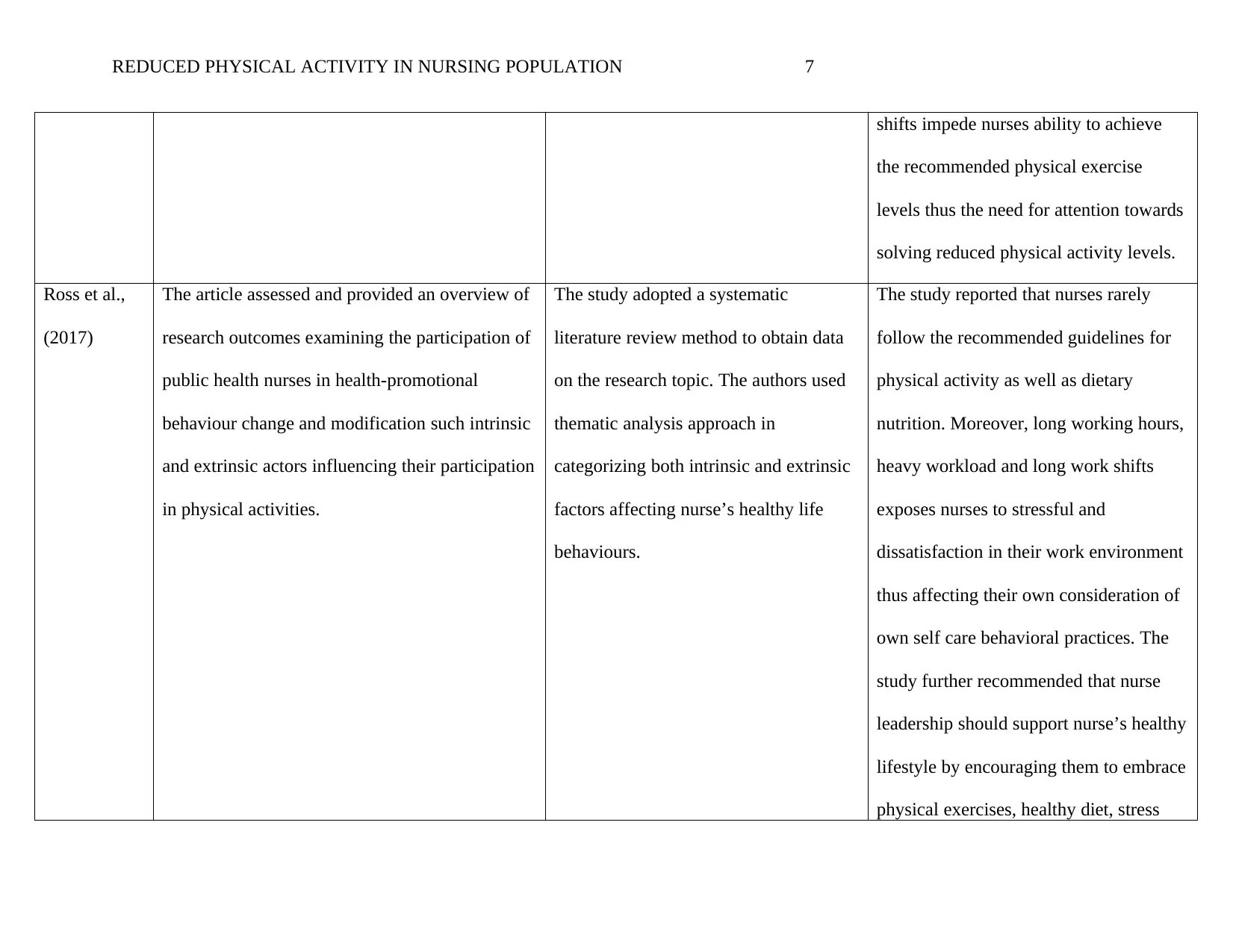
REDUCED PHYSICAL ACTIVITY IN NURSING POPULATION 7
shifts impede nurses ability to achieve
the recommended physical exercise
levels thus the need for attention towards
solving reduced physical activity levels.
Ross et al.,
(2017)
The article assessed and provided an overview of
research outcomes examining the participation of
public health nurses in health-promotional
behaviour change and modification such intrinsic
and extrinsic actors influencing their participation
in physical activities.
The study adopted a systematic
literature review method to obtain data
on the research topic. The authors used
thematic analysis approach in
categorizing both intrinsic and extrinsic
factors affecting nurse’s healthy life
behaviours.
The study reported that nurses rarely
follow the recommended guidelines for
physical activity as well as dietary
nutrition. Moreover, long working hours,
heavy workload and long work shifts
exposes nurses to stressful and
dissatisfaction in their work environment
thus affecting their own consideration of
own self care behavioral practices. The
study further recommended that nurse
leadership should support nurse’s healthy
lifestyle by encouraging them to embrace
physical exercises, healthy diet, stress
shifts impede nurses ability to achieve
the recommended physical exercise
levels thus the need for attention towards
solving reduced physical activity levels.
Ross et al.,
(2017)
The article assessed and provided an overview of
research outcomes examining the participation of
public health nurses in health-promotional
behaviour change and modification such intrinsic
and extrinsic actors influencing their participation
in physical activities.
The study adopted a systematic
literature review method to obtain data
on the research topic. The authors used
thematic analysis approach in
categorizing both intrinsic and extrinsic
factors affecting nurse’s healthy life
behaviours.
The study reported that nurses rarely
follow the recommended guidelines for
physical activity as well as dietary
nutrition. Moreover, long working hours,
heavy workload and long work shifts
exposes nurses to stressful and
dissatisfaction in their work environment
thus affecting their own consideration of
own self care behavioral practices. The
study further recommended that nurse
leadership should support nurse’s healthy
lifestyle by encouraging them to embrace
physical exercises, healthy diet, stress
Paraphrase This Document
Need a fresh take? Get an instant paraphrase of this document with our AI Paraphraser
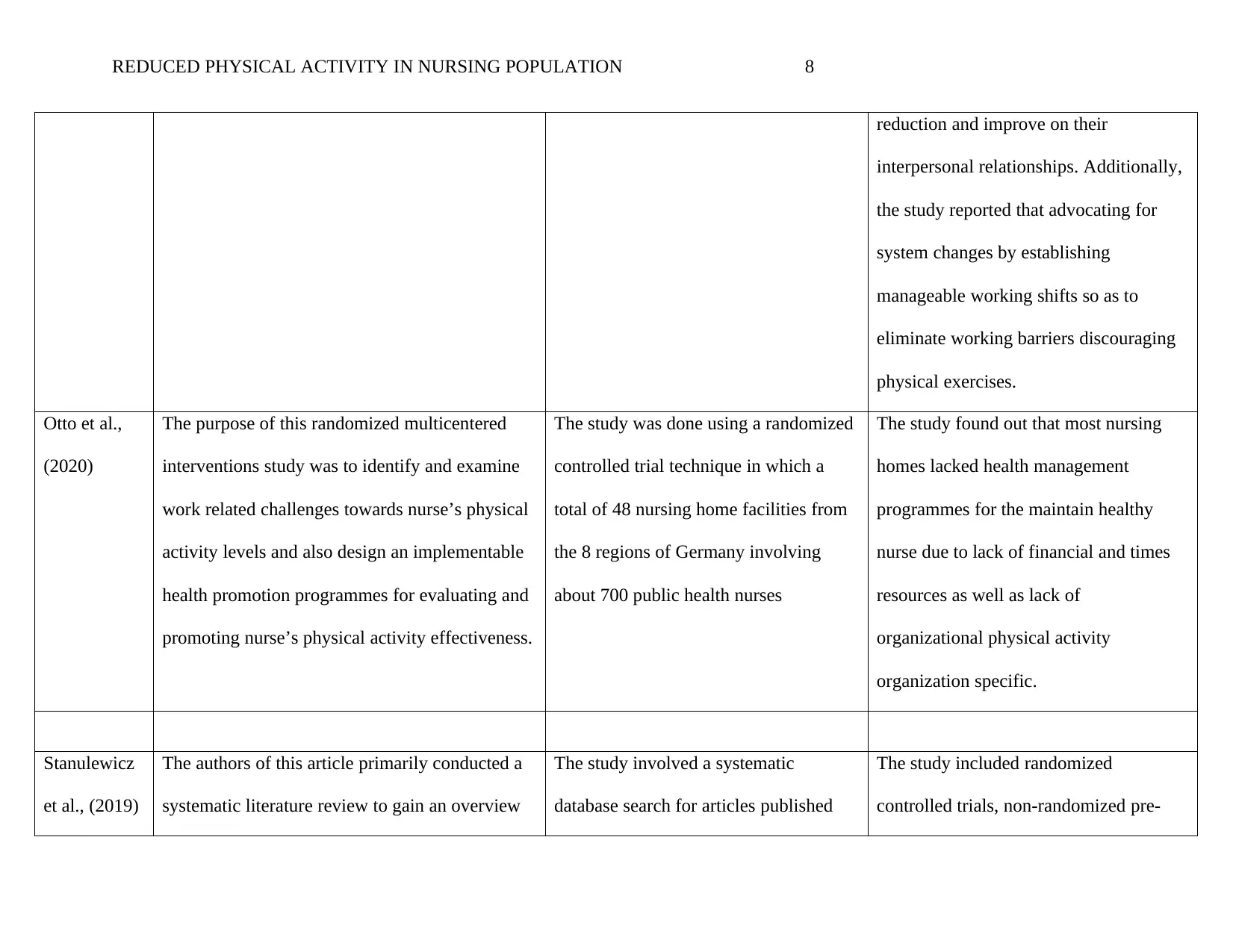
REDUCED PHYSICAL ACTIVITY IN NURSING POPULATION 8
reduction and improve on their
interpersonal relationships. Additionally,
the study reported that advocating for
system changes by establishing
manageable working shifts so as to
eliminate working barriers discouraging
physical exercises.
Otto et al.,
(2020)
The purpose of this randomized multicentered
interventions study was to identify and examine
work related challenges towards nurse’s physical
activity levels and also design an implementable
health promotion programmes for evaluating and
promoting nurse’s physical activity effectiveness.
The study was done using a randomized
controlled trial technique in which a
total of 48 nursing home facilities from
the 8 regions of Germany involving
about 700 public health nurses
The study found out that most nursing
homes lacked health management
programmes for the maintain healthy
nurse due to lack of financial and times
resources as well as lack of
organizational physical activity
organization specific.
Stanulewicz
et al., (2019)
The authors of this article primarily conducted a
systematic literature review to gain an overview
The study involved a systematic
database search for articles published
The study included randomized
controlled trials, non-randomized pre-
reduction and improve on their
interpersonal relationships. Additionally,
the study reported that advocating for
system changes by establishing
manageable working shifts so as to
eliminate working barriers discouraging
physical exercises.
Otto et al.,
(2020)
The purpose of this randomized multicentered
interventions study was to identify and examine
work related challenges towards nurse’s physical
activity levels and also design an implementable
health promotion programmes for evaluating and
promoting nurse’s physical activity effectiveness.
The study was done using a randomized
controlled trial technique in which a
total of 48 nursing home facilities from
the 8 regions of Germany involving
about 700 public health nurses
The study found out that most nursing
homes lacked health management
programmes for the maintain healthy
nurse due to lack of financial and times
resources as well as lack of
organizational physical activity
organization specific.
Stanulewicz
et al., (2019)
The authors of this article primarily conducted a
systematic literature review to gain an overview
The study involved a systematic
database search for articles published
The study included randomized
controlled trials, non-randomized pre-
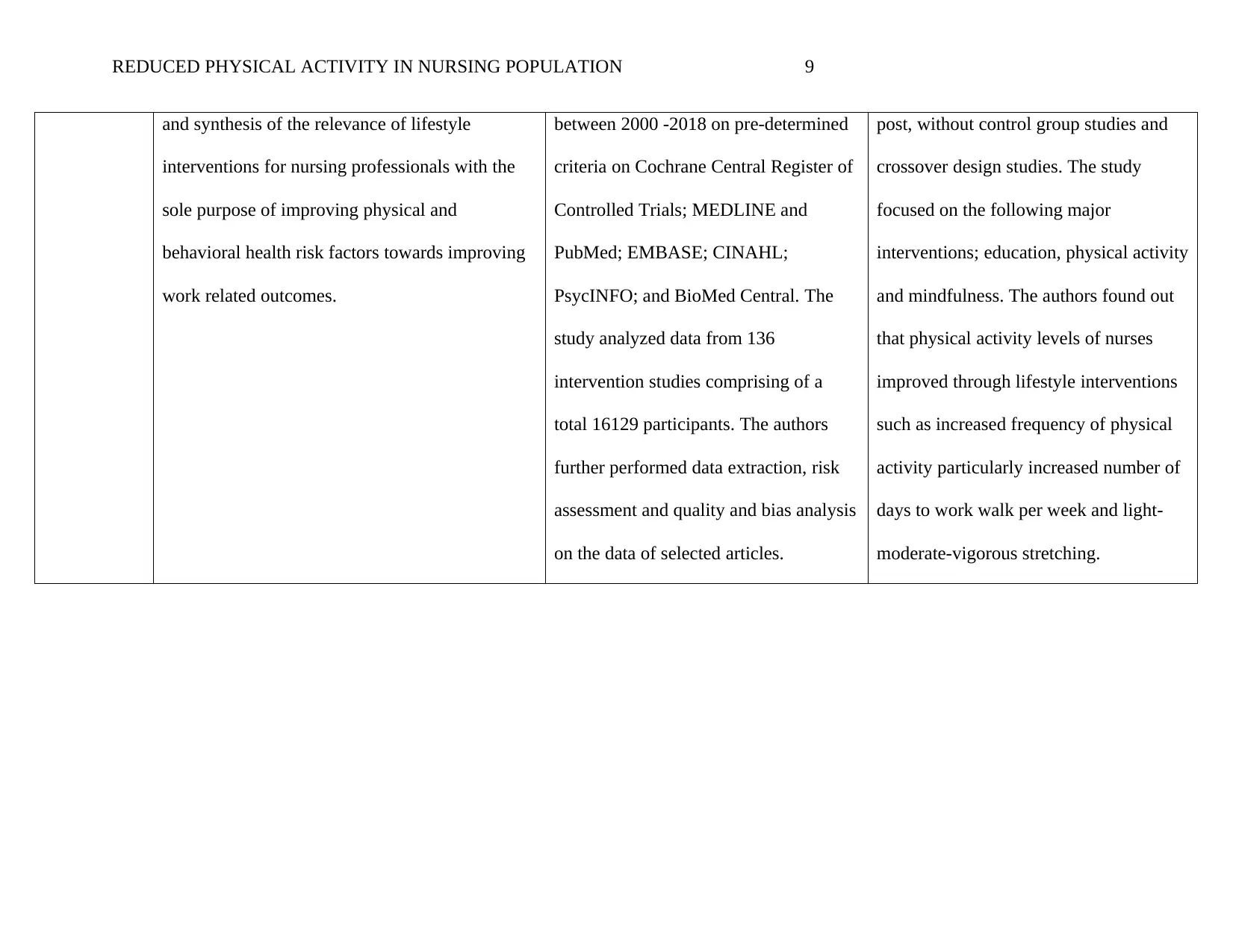
REDUCED PHYSICAL ACTIVITY IN NURSING POPULATION 9
and synthesis of the relevance of lifestyle
interventions for nursing professionals with the
sole purpose of improving physical and
behavioral health risk factors towards improving
work related outcomes.
between 2000 -2018 on pre-determined
criteria on Cochrane Central Register of
Controlled Trials; MEDLINE and
PubMed; EMBASE; CINAHL;
PsycINFO; and BioMed Central. The
study analyzed data from 136
intervention studies comprising of a
total 16129 participants. The authors
further performed data extraction, risk
assessment and quality and bias analysis
on the data of selected articles.
post, without control group studies and
crossover design studies. The study
focused on the following major
interventions; education, physical activity
and mindfulness. The authors found out
that physical activity levels of nurses
improved through lifestyle interventions
such as increased frequency of physical
activity particularly increased number of
days to work walk per week and light-
moderate-vigorous stretching.
and synthesis of the relevance of lifestyle
interventions for nursing professionals with the
sole purpose of improving physical and
behavioral health risk factors towards improving
work related outcomes.
between 2000 -2018 on pre-determined
criteria on Cochrane Central Register of
Controlled Trials; MEDLINE and
PubMed; EMBASE; CINAHL;
PsycINFO; and BioMed Central. The
study analyzed data from 136
intervention studies comprising of a
total 16129 participants. The authors
further performed data extraction, risk
assessment and quality and bias analysis
on the data of selected articles.
post, without control group studies and
crossover design studies. The study
focused on the following major
interventions; education, physical activity
and mindfulness. The authors found out
that physical activity levels of nurses
improved through lifestyle interventions
such as increased frequency of physical
activity particularly increased number of
days to work walk per week and light-
moderate-vigorous stretching.
You're viewing a preview
Unlock full access by subscribing today!
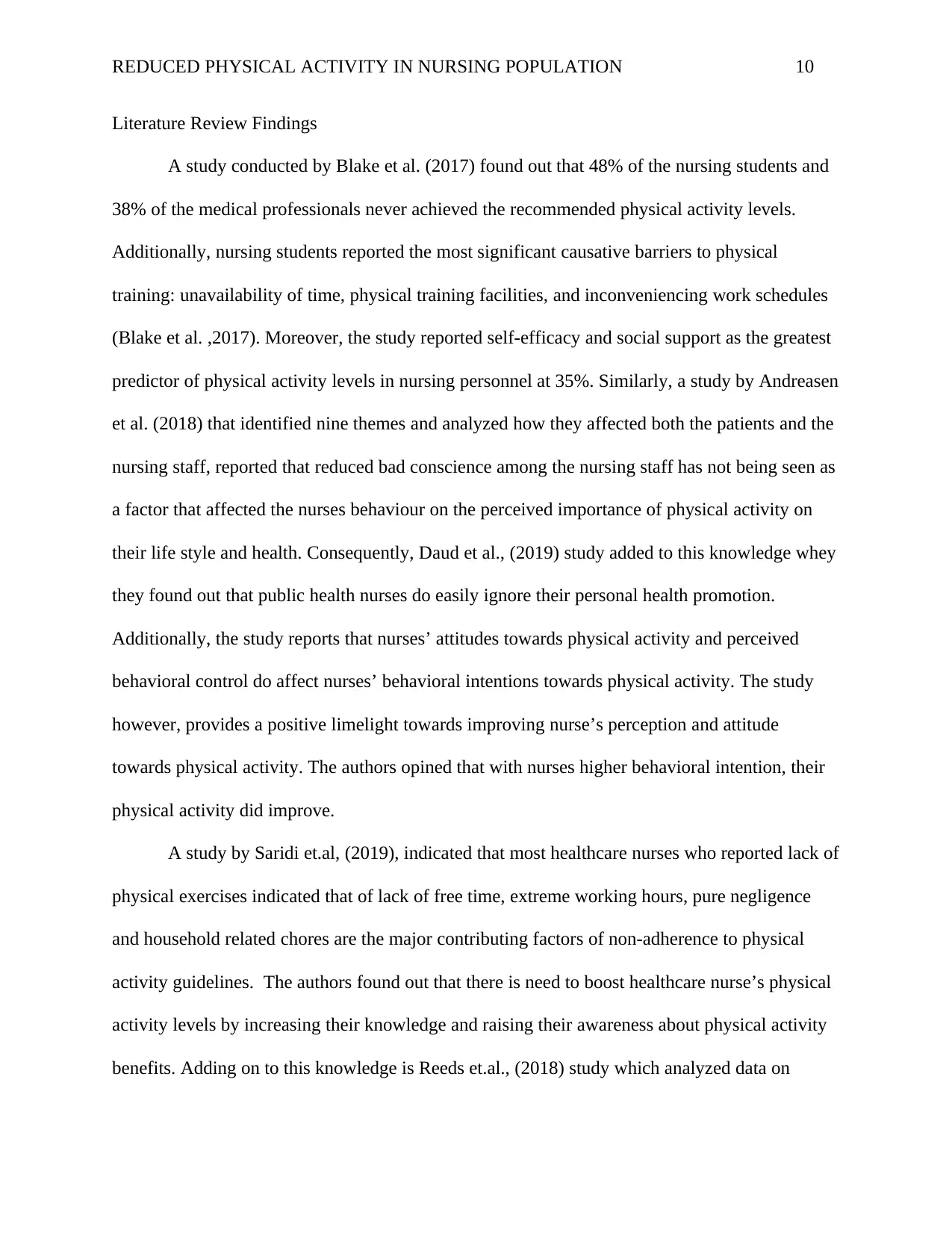
REDUCED PHYSICAL ACTIVITY IN NURSING POPULATION 10
Literature Review Findings
A study conducted by Blake et al. (2017) found out that 48% of the nursing students and
38% of the medical professionals never achieved the recommended physical activity levels.
Additionally, nursing students reported the most significant causative barriers to physical
training: unavailability of time, physical training facilities, and inconveniencing work schedules
(Blake et al. ,2017). Moreover, the study reported self-efficacy and social support as the greatest
predictor of physical activity levels in nursing personnel at 35%. Similarly, a study by Andreasen
et al. (2018) that identified nine themes and analyzed how they affected both the patients and the
nursing staff, reported that reduced bad conscience among the nursing staff has not being seen as
a factor that affected the nurses behaviour on the perceived importance of physical activity on
their life style and health. Consequently, Daud et al., (2019) study added to this knowledge whey
they found out that public health nurses do easily ignore their personal health promotion.
Additionally, the study reports that nurses’ attitudes towards physical activity and perceived
behavioral control do affect nurses’ behavioral intentions towards physical activity. The study
however, provides a positive limelight towards improving nurse’s perception and attitude
towards physical activity. The authors opined that with nurses higher behavioral intention, their
physical activity did improve.
A study by Saridi et.al, (2019), indicated that most healthcare nurses who reported lack of
physical exercises indicated that of lack of free time, extreme working hours, pure negligence
and household related chores are the major contributing factors of non-adherence to physical
activity guidelines. The authors found out that there is need to boost healthcare nurse’s physical
activity levels by increasing their knowledge and raising their awareness about physical activity
benefits. Adding on to this knowledge is Reeds et.al., (2018) study which analyzed data on
Literature Review Findings
A study conducted by Blake et al. (2017) found out that 48% of the nursing students and
38% of the medical professionals never achieved the recommended physical activity levels.
Additionally, nursing students reported the most significant causative barriers to physical
training: unavailability of time, physical training facilities, and inconveniencing work schedules
(Blake et al. ,2017). Moreover, the study reported self-efficacy and social support as the greatest
predictor of physical activity levels in nursing personnel at 35%. Similarly, a study by Andreasen
et al. (2018) that identified nine themes and analyzed how they affected both the patients and the
nursing staff, reported that reduced bad conscience among the nursing staff has not being seen as
a factor that affected the nurses behaviour on the perceived importance of physical activity on
their life style and health. Consequently, Daud et al., (2019) study added to this knowledge whey
they found out that public health nurses do easily ignore their personal health promotion.
Additionally, the study reports that nurses’ attitudes towards physical activity and perceived
behavioral control do affect nurses’ behavioral intentions towards physical activity. The study
however, provides a positive limelight towards improving nurse’s perception and attitude
towards physical activity. The authors opined that with nurses higher behavioral intention, their
physical activity did improve.
A study by Saridi et.al, (2019), indicated that most healthcare nurses who reported lack of
physical exercises indicated that of lack of free time, extreme working hours, pure negligence
and household related chores are the major contributing factors of non-adherence to physical
activity guidelines. The authors found out that there is need to boost healthcare nurse’s physical
activity levels by increasing their knowledge and raising their awareness about physical activity
benefits. Adding on to this knowledge is Reeds et.al., (2018) study which analyzed data on
Paraphrase This Document
Need a fresh take? Get an instant paraphrase of this document with our AI Paraphraser
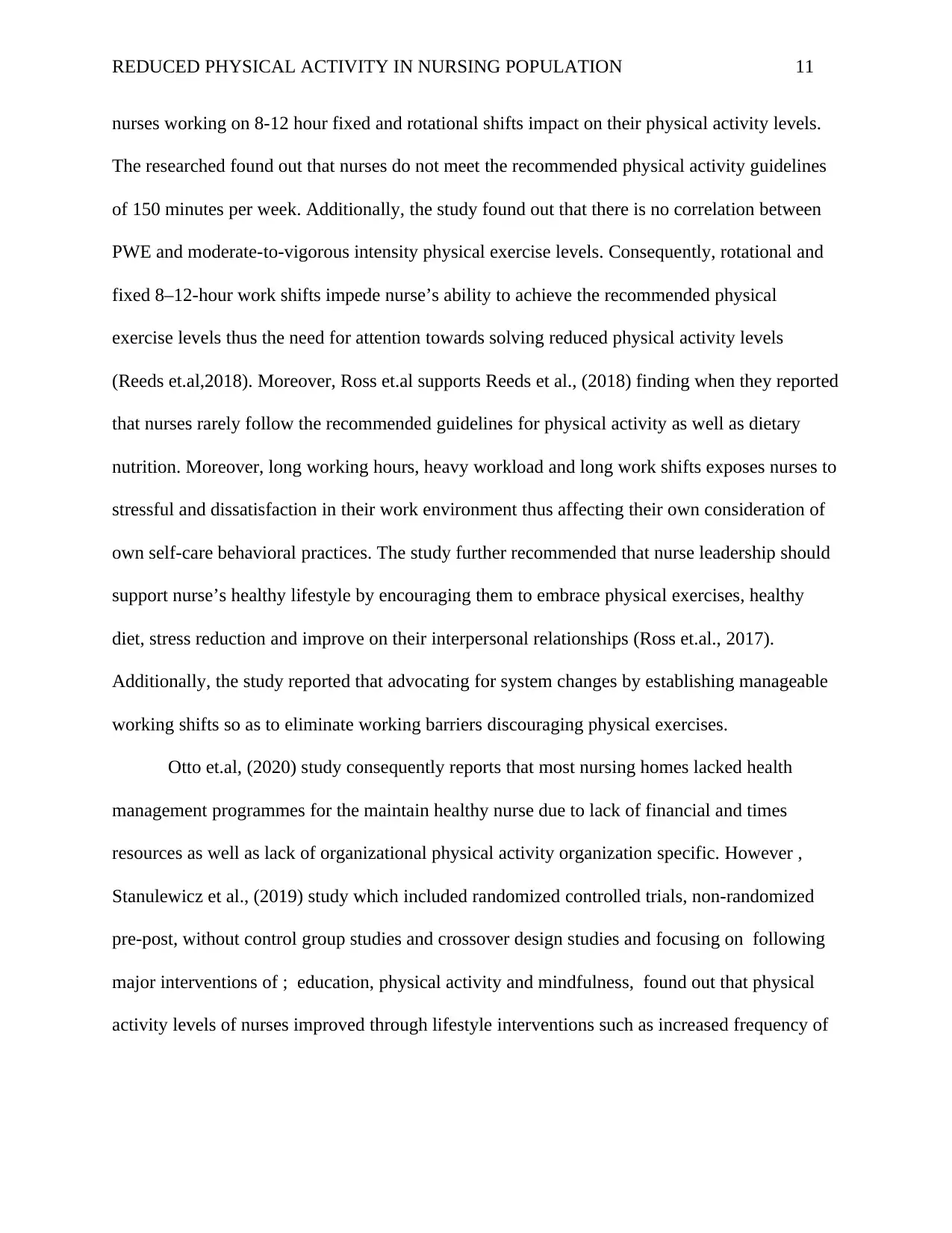
REDUCED PHYSICAL ACTIVITY IN NURSING POPULATION 11
nurses working on 8-12 hour fixed and rotational shifts impact on their physical activity levels.
The researched found out that nurses do not meet the recommended physical activity guidelines
of 150 minutes per week. Additionally, the study found out that there is no correlation between
PWE and moderate-to-vigorous intensity physical exercise levels. Consequently, rotational and
fixed 8–12-hour work shifts impede nurse’s ability to achieve the recommended physical
exercise levels thus the need for attention towards solving reduced physical activity levels
(Reeds et.al,2018). Moreover, Ross et.al supports Reeds et al., (2018) finding when they reported
that nurses rarely follow the recommended guidelines for physical activity as well as dietary
nutrition. Moreover, long working hours, heavy workload and long work shifts exposes nurses to
stressful and dissatisfaction in their work environment thus affecting their own consideration of
own self-care behavioral practices. The study further recommended that nurse leadership should
support nurse’s healthy lifestyle by encouraging them to embrace physical exercises, healthy
diet, stress reduction and improve on their interpersonal relationships (Ross et.al., 2017).
Additionally, the study reported that advocating for system changes by establishing manageable
working shifts so as to eliminate working barriers discouraging physical exercises.
Otto et.al, (2020) study consequently reports that most nursing homes lacked health
management programmes for the maintain healthy nurse due to lack of financial and times
resources as well as lack of organizational physical activity organization specific. However ,
Stanulewicz et al., (2019) study which included randomized controlled trials, non-randomized
pre-post, without control group studies and crossover design studies and focusing on following
major interventions of ; education, physical activity and mindfulness, found out that physical
activity levels of nurses improved through lifestyle interventions such as increased frequency of
nurses working on 8-12 hour fixed and rotational shifts impact on their physical activity levels.
The researched found out that nurses do not meet the recommended physical activity guidelines
of 150 minutes per week. Additionally, the study found out that there is no correlation between
PWE and moderate-to-vigorous intensity physical exercise levels. Consequently, rotational and
fixed 8–12-hour work shifts impede nurse’s ability to achieve the recommended physical
exercise levels thus the need for attention towards solving reduced physical activity levels
(Reeds et.al,2018). Moreover, Ross et.al supports Reeds et al., (2018) finding when they reported
that nurses rarely follow the recommended guidelines for physical activity as well as dietary
nutrition. Moreover, long working hours, heavy workload and long work shifts exposes nurses to
stressful and dissatisfaction in their work environment thus affecting their own consideration of
own self-care behavioral practices. The study further recommended that nurse leadership should
support nurse’s healthy lifestyle by encouraging them to embrace physical exercises, healthy
diet, stress reduction and improve on their interpersonal relationships (Ross et.al., 2017).
Additionally, the study reported that advocating for system changes by establishing manageable
working shifts so as to eliminate working barriers discouraging physical exercises.
Otto et.al, (2020) study consequently reports that most nursing homes lacked health
management programmes for the maintain healthy nurse due to lack of financial and times
resources as well as lack of organizational physical activity organization specific. However ,
Stanulewicz et al., (2019) study which included randomized controlled trials, non-randomized
pre-post, without control group studies and crossover design studies and focusing on following
major interventions of ; education, physical activity and mindfulness, found out that physical
activity levels of nurses improved through lifestyle interventions such as increased frequency of
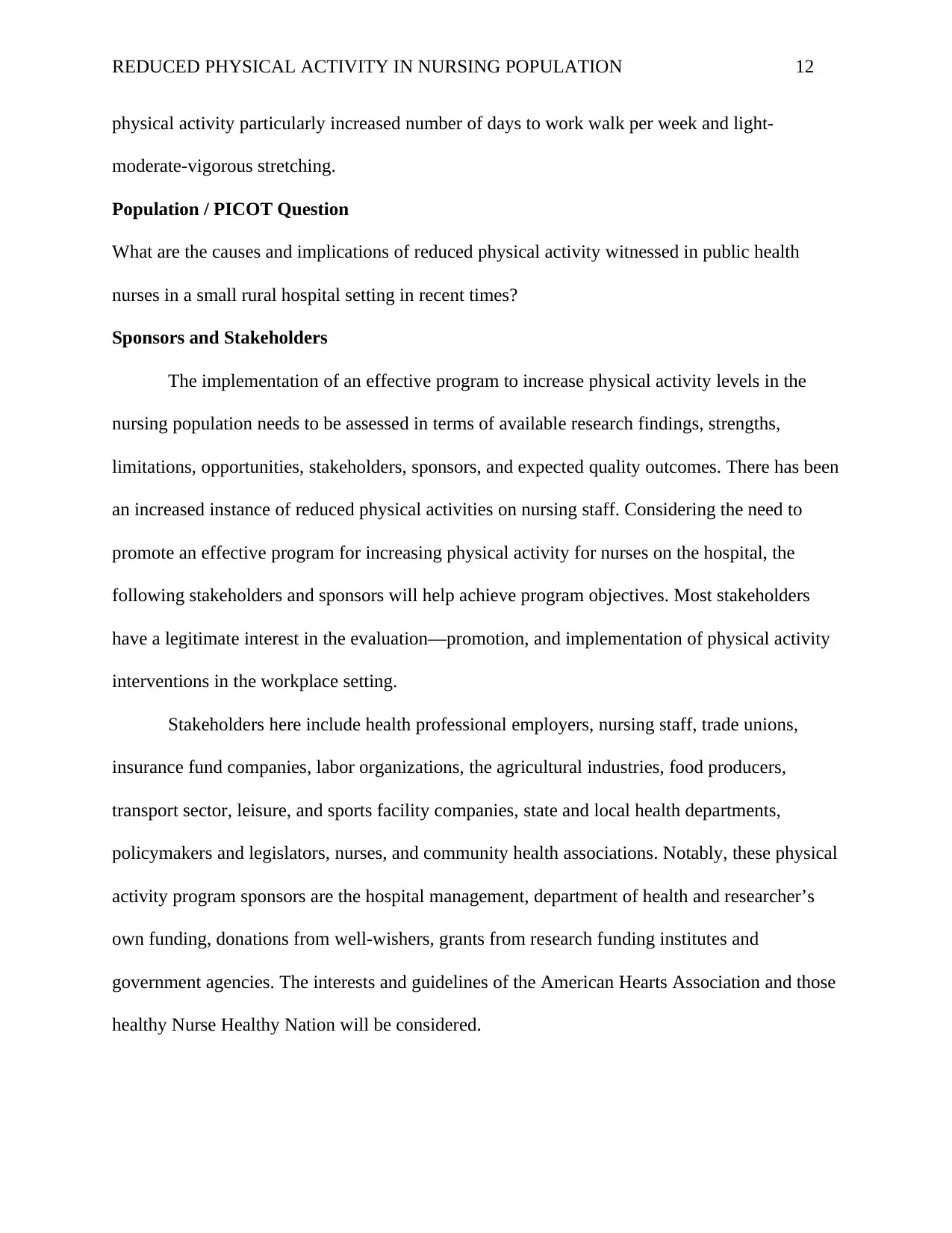
REDUCED PHYSICAL ACTIVITY IN NURSING POPULATION 12
physical activity particularly increased number of days to work walk per week and light-
moderate-vigorous stretching.
Population / PICOT Question
What are the causes and implications of reduced physical activity witnessed in public health
nurses in a small rural hospital setting in recent times?
Sponsors and Stakeholders
The implementation of an effective program to increase physical activity levels in the
nursing population needs to be assessed in terms of available research findings, strengths,
limitations, opportunities, stakeholders, sponsors, and expected quality outcomes. There has been
an increased instance of reduced physical activities on nursing staff. Considering the need to
promote an effective program for increasing physical activity for nurses on the hospital, the
following stakeholders and sponsors will help achieve program objectives. Most stakeholders
have a legitimate interest in the evaluation—promotion, and implementation of physical activity
interventions in the workplace setting.
Stakeholders here include health professional employers, nursing staff, trade unions,
insurance fund companies, labor organizations, the agricultural industries, food producers,
transport sector, leisure, and sports facility companies, state and local health departments,
policymakers and legislators, nurses, and community health associations. Notably, these physical
activity program sponsors are the hospital management, department of health and researcher’s
own funding, donations from well-wishers, grants from research funding institutes and
government agencies. The interests and guidelines of the American Hearts Association and those
healthy Nurse Healthy Nation will be considered.
physical activity particularly increased number of days to work walk per week and light-
moderate-vigorous stretching.
Population / PICOT Question
What are the causes and implications of reduced physical activity witnessed in public health
nurses in a small rural hospital setting in recent times?
Sponsors and Stakeholders
The implementation of an effective program to increase physical activity levels in the
nursing population needs to be assessed in terms of available research findings, strengths,
limitations, opportunities, stakeholders, sponsors, and expected quality outcomes. There has been
an increased instance of reduced physical activities on nursing staff. Considering the need to
promote an effective program for increasing physical activity for nurses on the hospital, the
following stakeholders and sponsors will help achieve program objectives. Most stakeholders
have a legitimate interest in the evaluation—promotion, and implementation of physical activity
interventions in the workplace setting.
Stakeholders here include health professional employers, nursing staff, trade unions,
insurance fund companies, labor organizations, the agricultural industries, food producers,
transport sector, leisure, and sports facility companies, state and local health departments,
policymakers and legislators, nurses, and community health associations. Notably, these physical
activity program sponsors are the hospital management, department of health and researcher’s
own funding, donations from well-wishers, grants from research funding institutes and
government agencies. The interests and guidelines of the American Hearts Association and those
healthy Nurse Healthy Nation will be considered.
You're viewing a preview
Unlock full access by subscribing today!
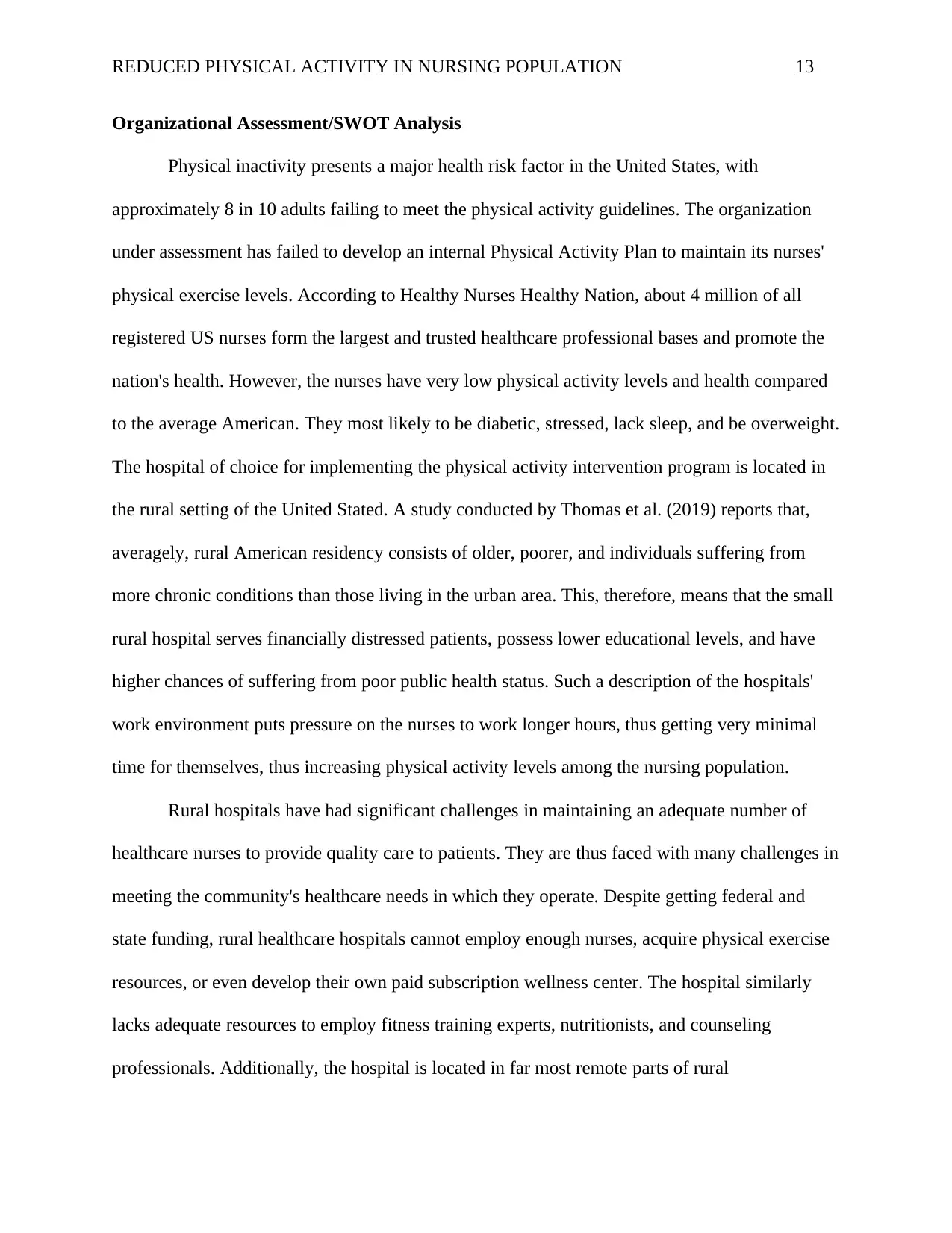
REDUCED PHYSICAL ACTIVITY IN NURSING POPULATION 13
Organizational Assessment/SWOT Analysis
Physical inactivity presents a major health risk factor in the United States, with
approximately 8 in 10 adults failing to meet the physical activity guidelines. The organization
under assessment has failed to develop an internal Physical Activity Plan to maintain its nurses'
physical exercise levels. According to Healthy Nurses Healthy Nation, about 4 million of all
registered US nurses form the largest and trusted healthcare professional bases and promote the
nation's health. However, the nurses have very low physical activity levels and health compared
to the average American. They most likely to be diabetic, stressed, lack sleep, and be overweight.
The hospital of choice for implementing the physical activity intervention program is located in
the rural setting of the United Stated. A study conducted by Thomas et al. (2019) reports that,
averagely, rural American residency consists of older, poorer, and individuals suffering from
more chronic conditions than those living in the urban area. This, therefore, means that the small
rural hospital serves financially distressed patients, possess lower educational levels, and have
higher chances of suffering from poor public health status. Such a description of the hospitals'
work environment puts pressure on the nurses to work longer hours, thus getting very minimal
time for themselves, thus increasing physical activity levels among the nursing population.
Rural hospitals have had significant challenges in maintaining an adequate number of
healthcare nurses to provide quality care to patients. They are thus faced with many challenges in
meeting the community's healthcare needs in which they operate. Despite getting federal and
state funding, rural healthcare hospitals cannot employ enough nurses, acquire physical exercise
resources, or even develop their own paid subscription wellness center. The hospital similarly
lacks adequate resources to employ fitness training experts, nutritionists, and counseling
professionals. Additionally, the hospital is located in far most remote parts of rural
Organizational Assessment/SWOT Analysis
Physical inactivity presents a major health risk factor in the United States, with
approximately 8 in 10 adults failing to meet the physical activity guidelines. The organization
under assessment has failed to develop an internal Physical Activity Plan to maintain its nurses'
physical exercise levels. According to Healthy Nurses Healthy Nation, about 4 million of all
registered US nurses form the largest and trusted healthcare professional bases and promote the
nation's health. However, the nurses have very low physical activity levels and health compared
to the average American. They most likely to be diabetic, stressed, lack sleep, and be overweight.
The hospital of choice for implementing the physical activity intervention program is located in
the rural setting of the United Stated. A study conducted by Thomas et al. (2019) reports that,
averagely, rural American residency consists of older, poorer, and individuals suffering from
more chronic conditions than those living in the urban area. This, therefore, means that the small
rural hospital serves financially distressed patients, possess lower educational levels, and have
higher chances of suffering from poor public health status. Such a description of the hospitals'
work environment puts pressure on the nurses to work longer hours, thus getting very minimal
time for themselves, thus increasing physical activity levels among the nursing population.
Rural hospitals have had significant challenges in maintaining an adequate number of
healthcare nurses to provide quality care to patients. They are thus faced with many challenges in
meeting the community's healthcare needs in which they operate. Despite getting federal and
state funding, rural healthcare hospitals cannot employ enough nurses, acquire physical exercise
resources, or even develop their own paid subscription wellness center. The hospital similarly
lacks adequate resources to employ fitness training experts, nutritionists, and counseling
professionals. Additionally, the hospital is located in far most remote parts of rural
Paraphrase This Document
Need a fresh take? Get an instant paraphrase of this document with our AI Paraphraser
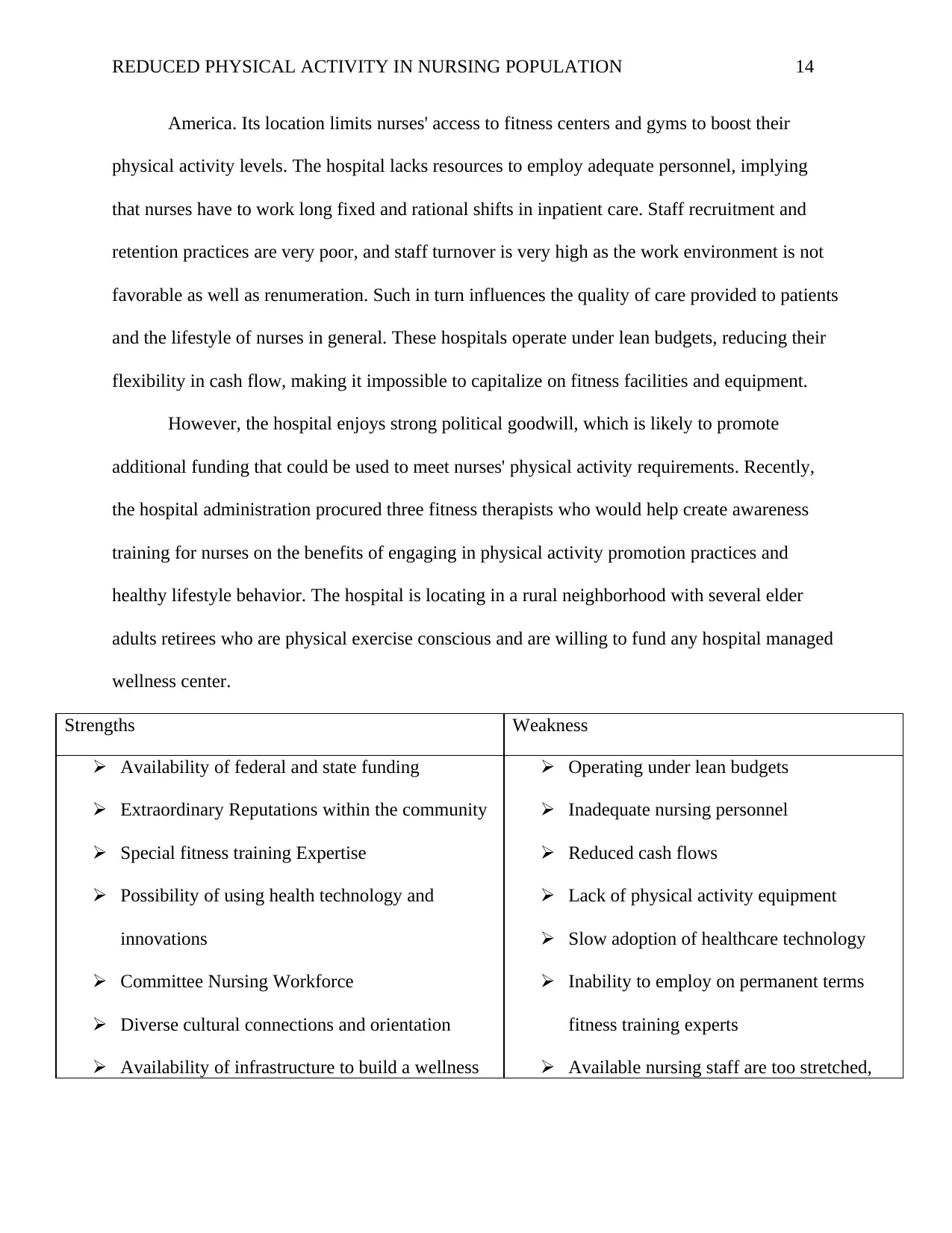
REDUCED PHYSICAL ACTIVITY IN NURSING POPULATION 14
America. Its location limits nurses' access to fitness centers and gyms to boost their
physical activity levels. The hospital lacks resources to employ adequate personnel, implying
that nurses have to work long fixed and rational shifts in inpatient care. Staff recruitment and
retention practices are very poor, and staff turnover is very high as the work environment is not
favorable as well as renumeration. Such in turn influences the quality of care provided to patients
and the lifestyle of nurses in general. These hospitals operate under lean budgets, reducing their
flexibility in cash flow, making it impossible to capitalize on fitness facilities and equipment.
However, the hospital enjoys strong political goodwill, which is likely to promote
additional funding that could be used to meet nurses' physical activity requirements. Recently,
the hospital administration procured three fitness therapists who would help create awareness
training for nurses on the benefits of engaging in physical activity promotion practices and
healthy lifestyle behavior. The hospital is locating in a rural neighborhood with several elder
adults retirees who are physical exercise conscious and are willing to fund any hospital managed
wellness center.
Strengths Weakness
Availability of federal and state funding
Extraordinary Reputations within the community
Special fitness training Expertise
Possibility of using health technology and
innovations
Committee Nursing Workforce
Diverse cultural connections and orientation
Availability of infrastructure to build a wellness
Operating under lean budgets
Inadequate nursing personnel
Reduced cash flows
Lack of physical activity equipment
Slow adoption of healthcare technology
Inability to employ on permanent terms
fitness training experts
Available nursing staff are too stretched,
America. Its location limits nurses' access to fitness centers and gyms to boost their
physical activity levels. The hospital lacks resources to employ adequate personnel, implying
that nurses have to work long fixed and rational shifts in inpatient care. Staff recruitment and
retention practices are very poor, and staff turnover is very high as the work environment is not
favorable as well as renumeration. Such in turn influences the quality of care provided to patients
and the lifestyle of nurses in general. These hospitals operate under lean budgets, reducing their
flexibility in cash flow, making it impossible to capitalize on fitness facilities and equipment.
However, the hospital enjoys strong political goodwill, which is likely to promote
additional funding that could be used to meet nurses' physical activity requirements. Recently,
the hospital administration procured three fitness therapists who would help create awareness
training for nurses on the benefits of engaging in physical activity promotion practices and
healthy lifestyle behavior. The hospital is locating in a rural neighborhood with several elder
adults retirees who are physical exercise conscious and are willing to fund any hospital managed
wellness center.
Strengths Weakness
Availability of federal and state funding
Extraordinary Reputations within the community
Special fitness training Expertise
Possibility of using health technology and
innovations
Committee Nursing Workforce
Diverse cultural connections and orientation
Availability of infrastructure to build a wellness
Operating under lean budgets
Inadequate nursing personnel
Reduced cash flows
Lack of physical activity equipment
Slow adoption of healthcare technology
Inability to employ on permanent terms
fitness training experts
Available nursing staff are too stretched,
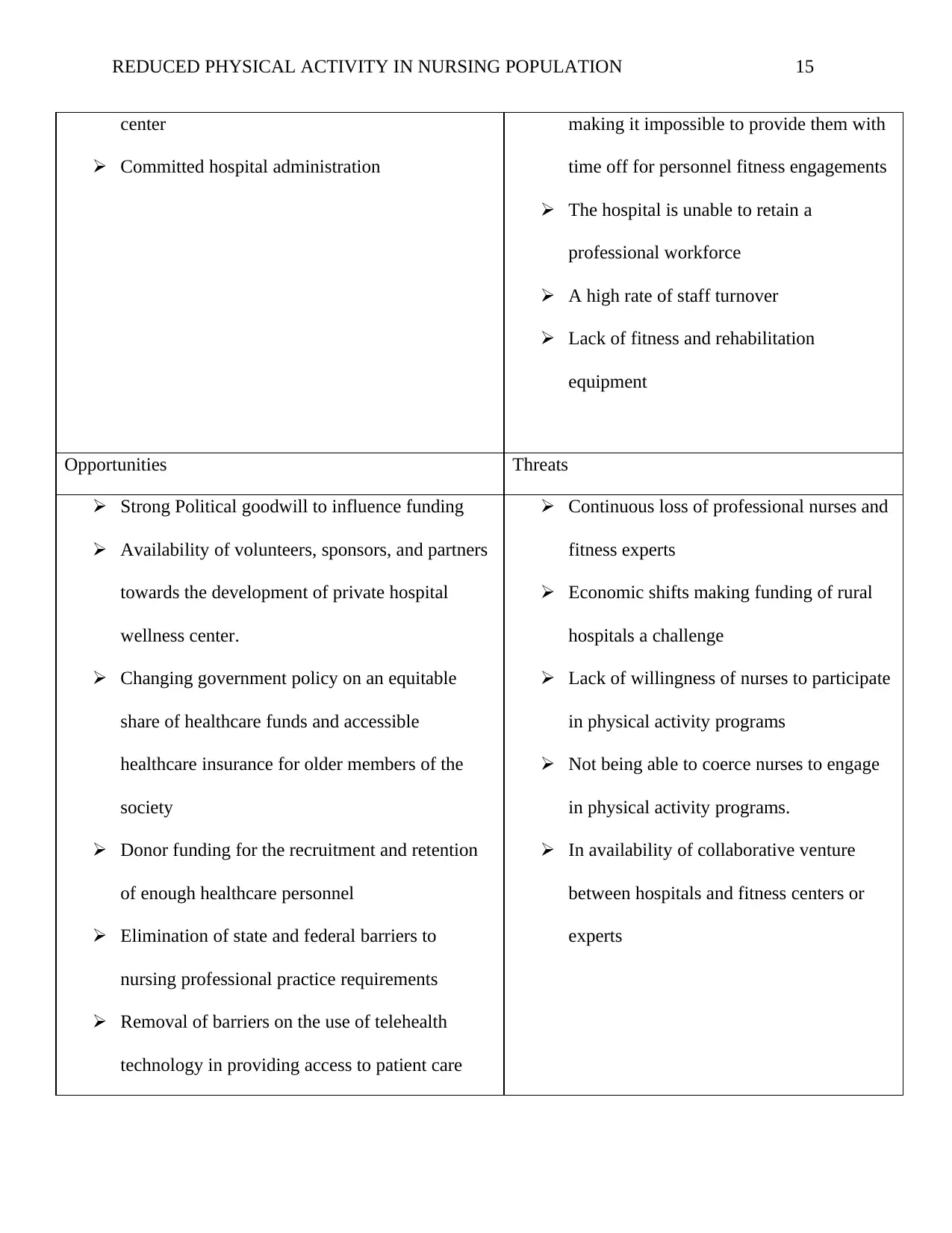
REDUCED PHYSICAL ACTIVITY IN NURSING POPULATION 15
center
Committed hospital administration
making it impossible to provide them with
time off for personnel fitness engagements
The hospital is unable to retain a
professional workforce
A high rate of staff turnover
Lack of fitness and rehabilitation
equipment
Opportunities Threats
Strong Political goodwill to influence funding
Availability of volunteers, sponsors, and partners
towards the development of private hospital
wellness center.
Changing government policy on an equitable
share of healthcare funds and accessible
healthcare insurance for older members of the
society
Donor funding for the recruitment and retention
of enough healthcare personnel
Elimination of state and federal barriers to
nursing professional practice requirements
Removal of barriers on the use of telehealth
technology in providing access to patient care
Continuous loss of professional nurses and
fitness experts
Economic shifts making funding of rural
hospitals a challenge
Lack of willingness of nurses to participate
in physical activity programs
Not being able to coerce nurses to engage
in physical activity programs.
In availability of collaborative venture
between hospitals and fitness centers or
experts
center
Committed hospital administration
making it impossible to provide them with
time off for personnel fitness engagements
The hospital is unable to retain a
professional workforce
A high rate of staff turnover
Lack of fitness and rehabilitation
equipment
Opportunities Threats
Strong Political goodwill to influence funding
Availability of volunteers, sponsors, and partners
towards the development of private hospital
wellness center.
Changing government policy on an equitable
share of healthcare funds and accessible
healthcare insurance for older members of the
society
Donor funding for the recruitment and retention
of enough healthcare personnel
Elimination of state and federal barriers to
nursing professional practice requirements
Removal of barriers on the use of telehealth
technology in providing access to patient care
Continuous loss of professional nurses and
fitness experts
Economic shifts making funding of rural
hospitals a challenge
Lack of willingness of nurses to participate
in physical activity programs
Not being able to coerce nurses to engage
in physical activity programs.
In availability of collaborative venture
between hospitals and fitness centers or
experts
You're viewing a preview
Unlock full access by subscribing today!
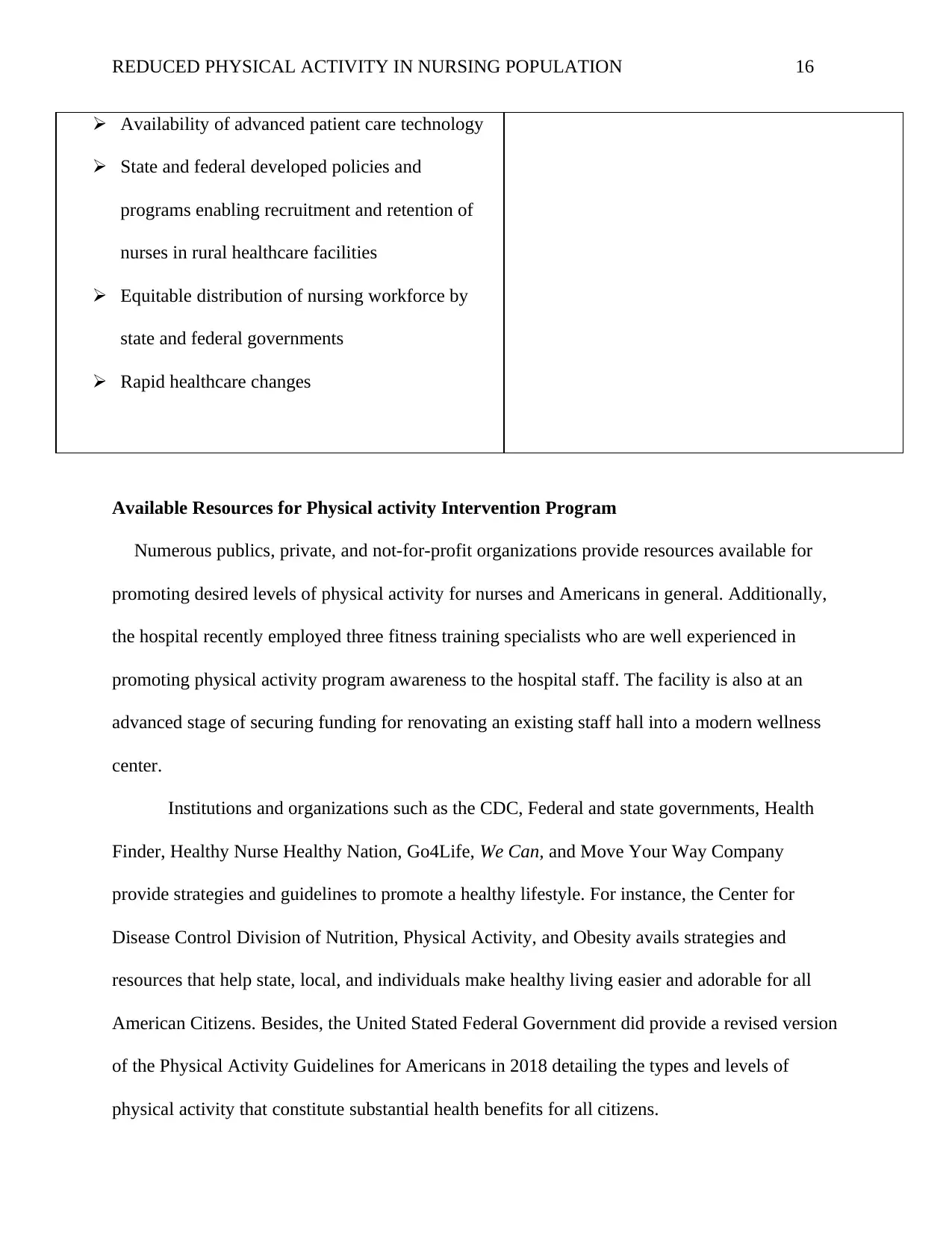
REDUCED PHYSICAL ACTIVITY IN NURSING POPULATION 16
Availability of advanced patient care technology
State and federal developed policies and
programs enabling recruitment and retention of
nurses in rural healthcare facilities
Equitable distribution of nursing workforce by
state and federal governments
Rapid healthcare changes
Available Resources for Physical activity Intervention Program
Numerous publics, private, and not-for-profit organizations provide resources available for
promoting desired levels of physical activity for nurses and Americans in general. Additionally,
the hospital recently employed three fitness training specialists who are well experienced in
promoting physical activity program awareness to the hospital staff. The facility is also at an
advanced stage of securing funding for renovating an existing staff hall into a modern wellness
center.
Institutions and organizations such as the CDC, Federal and state governments, Health
Finder, Healthy Nurse Healthy Nation, Go4Life, We Can, and Move Your Way Company
provide strategies and guidelines to promote a healthy lifestyle. For instance, the Center for
Disease Control Division of Nutrition, Physical Activity, and Obesity avails strategies and
resources that help state, local, and individuals make healthy living easier and adorable for all
American Citizens. Besides, the United Stated Federal Government did provide a revised version
of the Physical Activity Guidelines for Americans in 2018 detailing the types and levels of
physical activity that constitute substantial health benefits for all citizens.
Availability of advanced patient care technology
State and federal developed policies and
programs enabling recruitment and retention of
nurses in rural healthcare facilities
Equitable distribution of nursing workforce by
state and federal governments
Rapid healthcare changes
Available Resources for Physical activity Intervention Program
Numerous publics, private, and not-for-profit organizations provide resources available for
promoting desired levels of physical activity for nurses and Americans in general. Additionally,
the hospital recently employed three fitness training specialists who are well experienced in
promoting physical activity program awareness to the hospital staff. The facility is also at an
advanced stage of securing funding for renovating an existing staff hall into a modern wellness
center.
Institutions and organizations such as the CDC, Federal and state governments, Health
Finder, Healthy Nurse Healthy Nation, Go4Life, We Can, and Move Your Way Company
provide strategies and guidelines to promote a healthy lifestyle. For instance, the Center for
Disease Control Division of Nutrition, Physical Activity, and Obesity avails strategies and
resources that help state, local, and individuals make healthy living easier and adorable for all
American Citizens. Besides, the United Stated Federal Government did provide a revised version
of the Physical Activity Guidelines for Americans in 2018 detailing the types and levels of
physical activity that constitute substantial health benefits for all citizens.
Paraphrase This Document
Need a fresh take? Get an instant paraphrase of this document with our AI Paraphraser
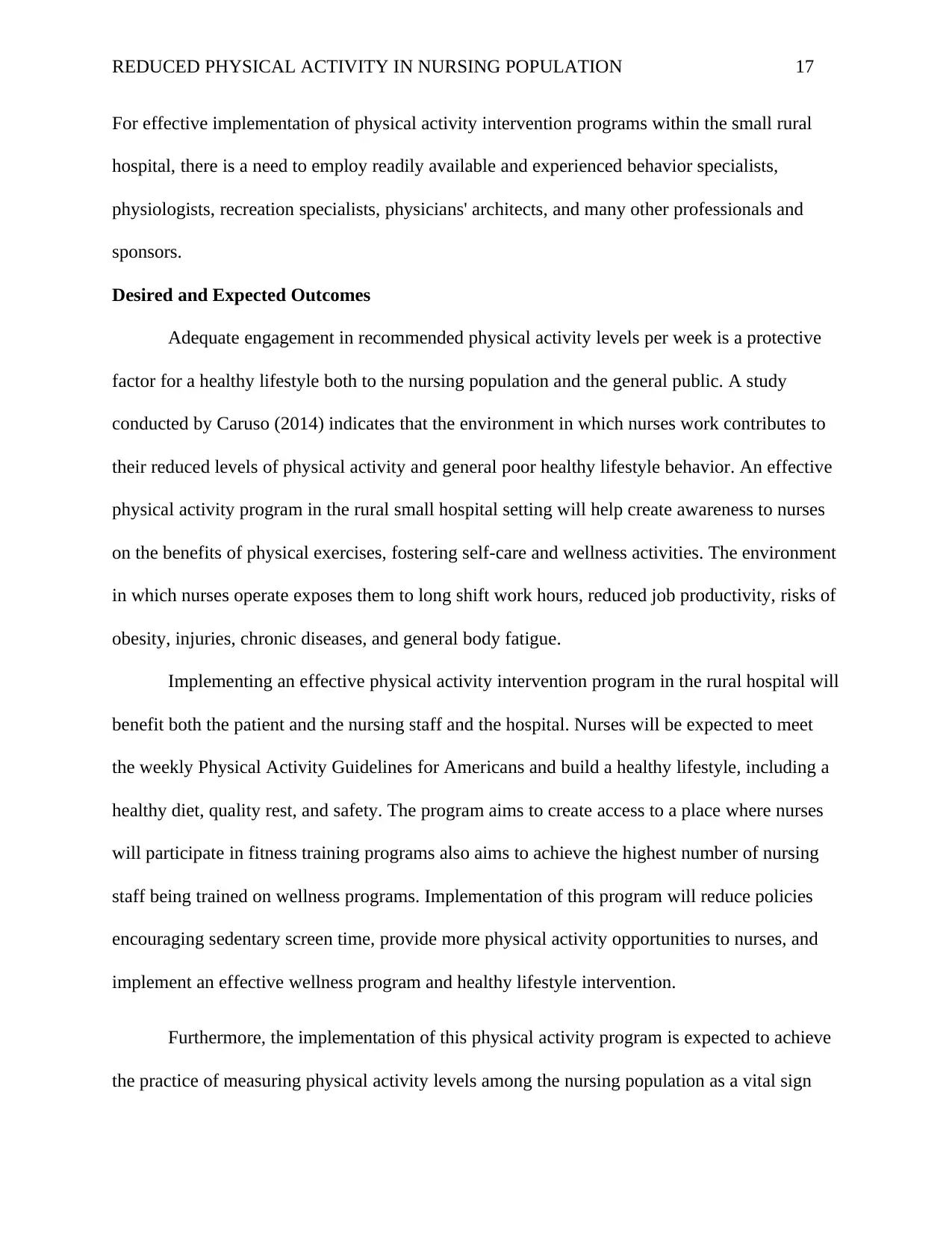
REDUCED PHYSICAL ACTIVITY IN NURSING POPULATION 17
For effective implementation of physical activity intervention programs within the small rural
hospital, there is a need to employ readily available and experienced behavior specialists,
physiologists, recreation specialists, physicians' architects, and many other professionals and
sponsors.
Desired and Expected Outcomes
Adequate engagement in recommended physical activity levels per week is a protective
factor for a healthy lifestyle both to the nursing population and the general public. A study
conducted by Caruso (2014) indicates that the environment in which nurses work contributes to
their reduced levels of physical activity and general poor healthy lifestyle behavior. An effective
physical activity program in the rural small hospital setting will help create awareness to nurses
on the benefits of physical exercises, fostering self-care and wellness activities. The environment
in which nurses operate exposes them to long shift work hours, reduced job productivity, risks of
obesity, injuries, chronic diseases, and general body fatigue.
Implementing an effective physical activity intervention program in the rural hospital will
benefit both the patient and the nursing staff and the hospital. Nurses will be expected to meet
the weekly Physical Activity Guidelines for Americans and build a healthy lifestyle, including a
healthy diet, quality rest, and safety. The program aims to create access to a place where nurses
will participate in fitness training programs also aims to achieve the highest number of nursing
staff being trained on wellness programs. Implementation of this program will reduce policies
encouraging sedentary screen time, provide more physical activity opportunities to nurses, and
implement an effective wellness program and healthy lifestyle intervention.
Furthermore, the implementation of this physical activity program is expected to achieve
the practice of measuring physical activity levels among the nursing population as a vital sign
For effective implementation of physical activity intervention programs within the small rural
hospital, there is a need to employ readily available and experienced behavior specialists,
physiologists, recreation specialists, physicians' architects, and many other professionals and
sponsors.
Desired and Expected Outcomes
Adequate engagement in recommended physical activity levels per week is a protective
factor for a healthy lifestyle both to the nursing population and the general public. A study
conducted by Caruso (2014) indicates that the environment in which nurses work contributes to
their reduced levels of physical activity and general poor healthy lifestyle behavior. An effective
physical activity program in the rural small hospital setting will help create awareness to nurses
on the benefits of physical exercises, fostering self-care and wellness activities. The environment
in which nurses operate exposes them to long shift work hours, reduced job productivity, risks of
obesity, injuries, chronic diseases, and general body fatigue.
Implementing an effective physical activity intervention program in the rural hospital will
benefit both the patient and the nursing staff and the hospital. Nurses will be expected to meet
the weekly Physical Activity Guidelines for Americans and build a healthy lifestyle, including a
healthy diet, quality rest, and safety. The program aims to create access to a place where nurses
will participate in fitness training programs also aims to achieve the highest number of nursing
staff being trained on wellness programs. Implementation of this program will reduce policies
encouraging sedentary screen time, provide more physical activity opportunities to nurses, and
implement an effective wellness program and healthy lifestyle intervention.
Furthermore, the implementation of this physical activity program is expected to achieve
the practice of measuring physical activity levels among the nursing population as a vital sign
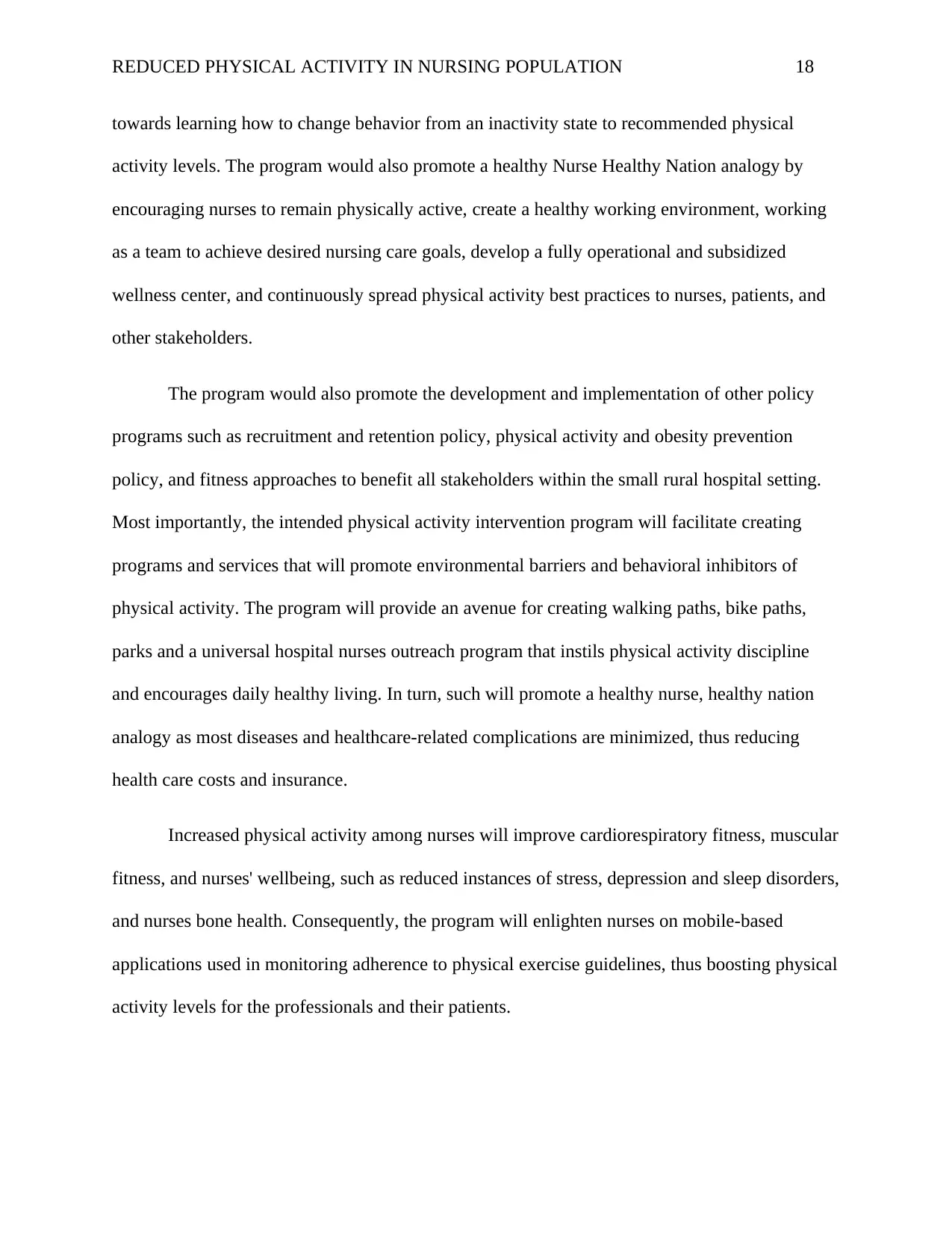
REDUCED PHYSICAL ACTIVITY IN NURSING POPULATION 18
towards learning how to change behavior from an inactivity state to recommended physical
activity levels. The program would also promote a healthy Nurse Healthy Nation analogy by
encouraging nurses to remain physically active, create a healthy working environment, working
as a team to achieve desired nursing care goals, develop a fully operational and subsidized
wellness center, and continuously spread physical activity best practices to nurses, patients, and
other stakeholders.
The program would also promote the development and implementation of other policy
programs such as recruitment and retention policy, physical activity and obesity prevention
policy, and fitness approaches to benefit all stakeholders within the small rural hospital setting.
Most importantly, the intended physical activity intervention program will facilitate creating
programs and services that will promote environmental barriers and behavioral inhibitors of
physical activity. The program will provide an avenue for creating walking paths, bike paths,
parks and a universal hospital nurses outreach program that instils physical activity discipline
and encourages daily healthy living. In turn, such will promote a healthy nurse, healthy nation
analogy as most diseases and healthcare-related complications are minimized, thus reducing
health care costs and insurance.
Increased physical activity among nurses will improve cardiorespiratory fitness, muscular
fitness, and nurses' wellbeing, such as reduced instances of stress, depression and sleep disorders,
and nurses bone health. Consequently, the program will enlighten nurses on mobile-based
applications used in monitoring adherence to physical exercise guidelines, thus boosting physical
activity levels for the professionals and their patients.
towards learning how to change behavior from an inactivity state to recommended physical
activity levels. The program would also promote a healthy Nurse Healthy Nation analogy by
encouraging nurses to remain physically active, create a healthy working environment, working
as a team to achieve desired nursing care goals, develop a fully operational and subsidized
wellness center, and continuously spread physical activity best practices to nurses, patients, and
other stakeholders.
The program would also promote the development and implementation of other policy
programs such as recruitment and retention policy, physical activity and obesity prevention
policy, and fitness approaches to benefit all stakeholders within the small rural hospital setting.
Most importantly, the intended physical activity intervention program will facilitate creating
programs and services that will promote environmental barriers and behavioral inhibitors of
physical activity. The program will provide an avenue for creating walking paths, bike paths,
parks and a universal hospital nurses outreach program that instils physical activity discipline
and encourages daily healthy living. In turn, such will promote a healthy nurse, healthy nation
analogy as most diseases and healthcare-related complications are minimized, thus reducing
health care costs and insurance.
Increased physical activity among nurses will improve cardiorespiratory fitness, muscular
fitness, and nurses' wellbeing, such as reduced instances of stress, depression and sleep disorders,
and nurses bone health. Consequently, the program will enlighten nurses on mobile-based
applications used in monitoring adherence to physical exercise guidelines, thus boosting physical
activity levels for the professionals and their patients.
You're viewing a preview
Unlock full access by subscribing today!
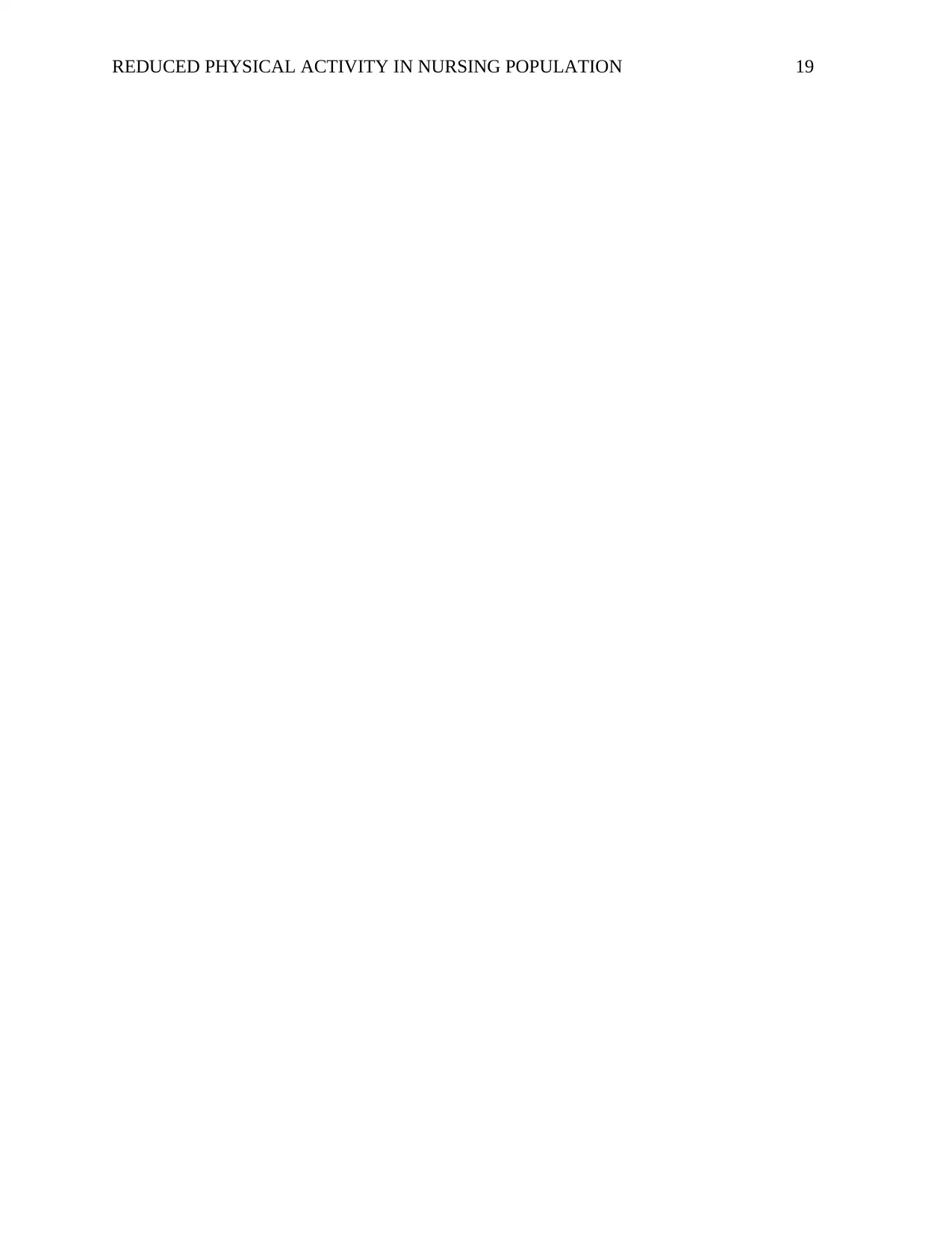
REDUCED PHYSICAL ACTIVITY IN NURSING POPULATION 19
Paraphrase This Document
Need a fresh take? Get an instant paraphrase of this document with our AI Paraphraser
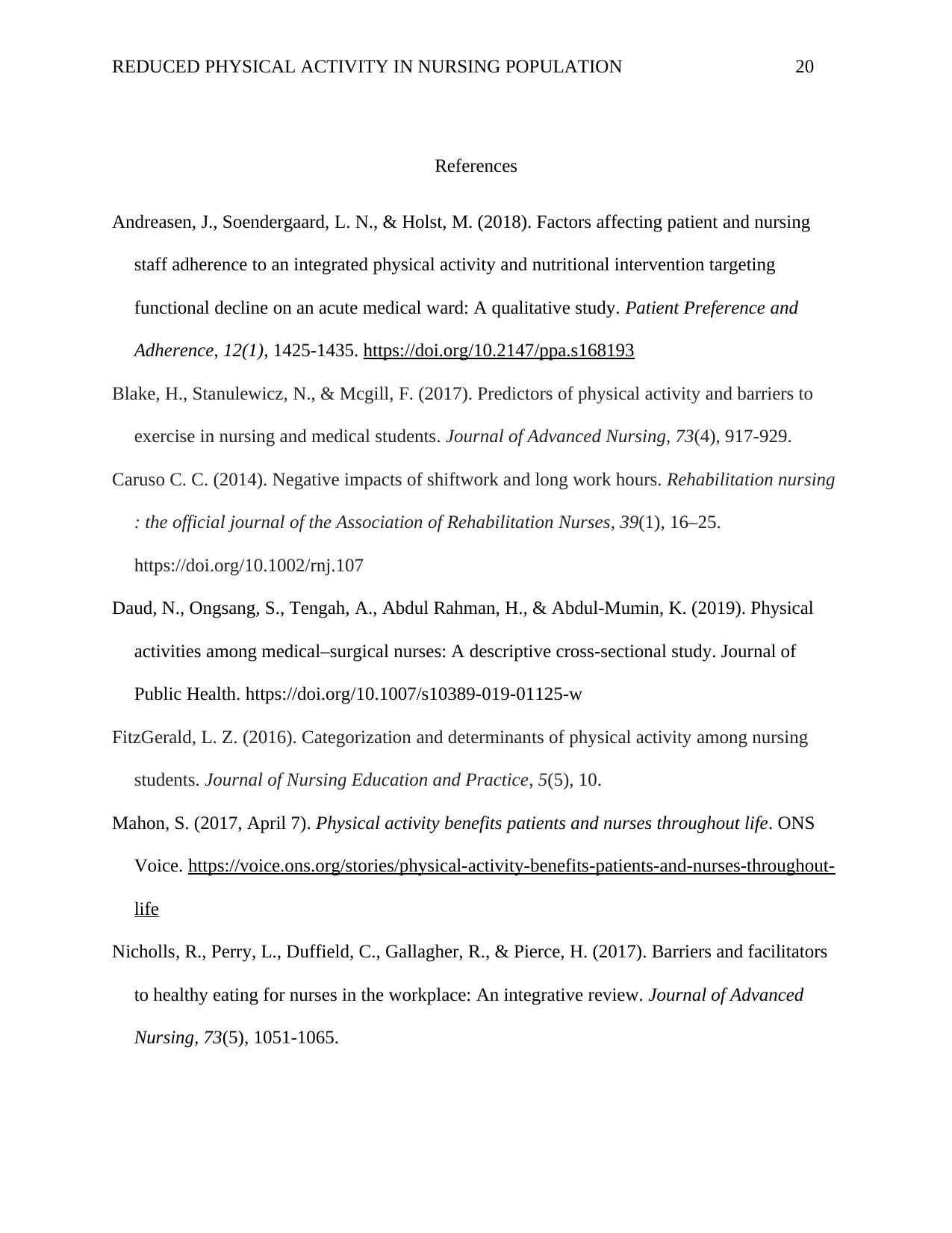
REDUCED PHYSICAL ACTIVITY IN NURSING POPULATION 20
References
Andreasen, J., Soendergaard, L. N., & Holst, M. (2018). Factors affecting patient and nursing
staff adherence to an integrated physical activity and nutritional intervention targeting
functional decline on an acute medical ward: A qualitative study. Patient Preference and
Adherence, 12(1), 1425-1435. https://doi.org/10.2147/ppa.s168193
Blake, H., Stanulewicz, N., & Mcgill, F. (2017). Predictors of physical activity and barriers to
exercise in nursing and medical students. Journal of Advanced Nursing, 73(4), 917-929.
Caruso C. C. (2014). Negative impacts of shiftwork and long work hours. Rehabilitation nursing
: the official journal of the Association of Rehabilitation Nurses, 39(1), 16–25.
https://doi.org/10.1002/rnj.107
Daud, N., Ongsang, S., Tengah, A., Abdul Rahman, H., & Abdul-Mumin, K. (2019). Physical
activities among medical–surgical nurses: A descriptive cross-sectional study. Journal of
Public Health. https://doi.org/10.1007/s10389-019-01125-w
FitzGerald, L. Z. (2016). Categorization and determinants of physical activity among nursing
students. Journal of Nursing Education and Practice, 5(5), 10.
Mahon, S. (2017, April 7). Physical activity benefits patients and nurses throughout life. ONS
Voice. https://voice.ons.org/stories/physical-activity-benefits-patients-and-nurses-throughout-
life
Nicholls, R., Perry, L., Duffield, C., Gallagher, R., & Pierce, H. (2017). Barriers and facilitators
to healthy eating for nurses in the workplace: An integrative review. Journal of Advanced
Nursing, 73(5), 1051-1065.
References
Andreasen, J., Soendergaard, L. N., & Holst, M. (2018). Factors affecting patient and nursing
staff adherence to an integrated physical activity and nutritional intervention targeting
functional decline on an acute medical ward: A qualitative study. Patient Preference and
Adherence, 12(1), 1425-1435. https://doi.org/10.2147/ppa.s168193
Blake, H., Stanulewicz, N., & Mcgill, F. (2017). Predictors of physical activity and barriers to
exercise in nursing and medical students. Journal of Advanced Nursing, 73(4), 917-929.
Caruso C. C. (2014). Negative impacts of shiftwork and long work hours. Rehabilitation nursing
: the official journal of the Association of Rehabilitation Nurses, 39(1), 16–25.
https://doi.org/10.1002/rnj.107
Daud, N., Ongsang, S., Tengah, A., Abdul Rahman, H., & Abdul-Mumin, K. (2019). Physical
activities among medical–surgical nurses: A descriptive cross-sectional study. Journal of
Public Health. https://doi.org/10.1007/s10389-019-01125-w
FitzGerald, L. Z. (2016). Categorization and determinants of physical activity among nursing
students. Journal of Nursing Education and Practice, 5(5), 10.
Mahon, S. (2017, April 7). Physical activity benefits patients and nurses throughout life. ONS
Voice. https://voice.ons.org/stories/physical-activity-benefits-patients-and-nurses-throughout-
life
Nicholls, R., Perry, L., Duffield, C., Gallagher, R., & Pierce, H. (2017). Barriers and facilitators
to healthy eating for nurses in the workplace: An integrative review. Journal of Advanced
Nursing, 73(5), 1051-1065.
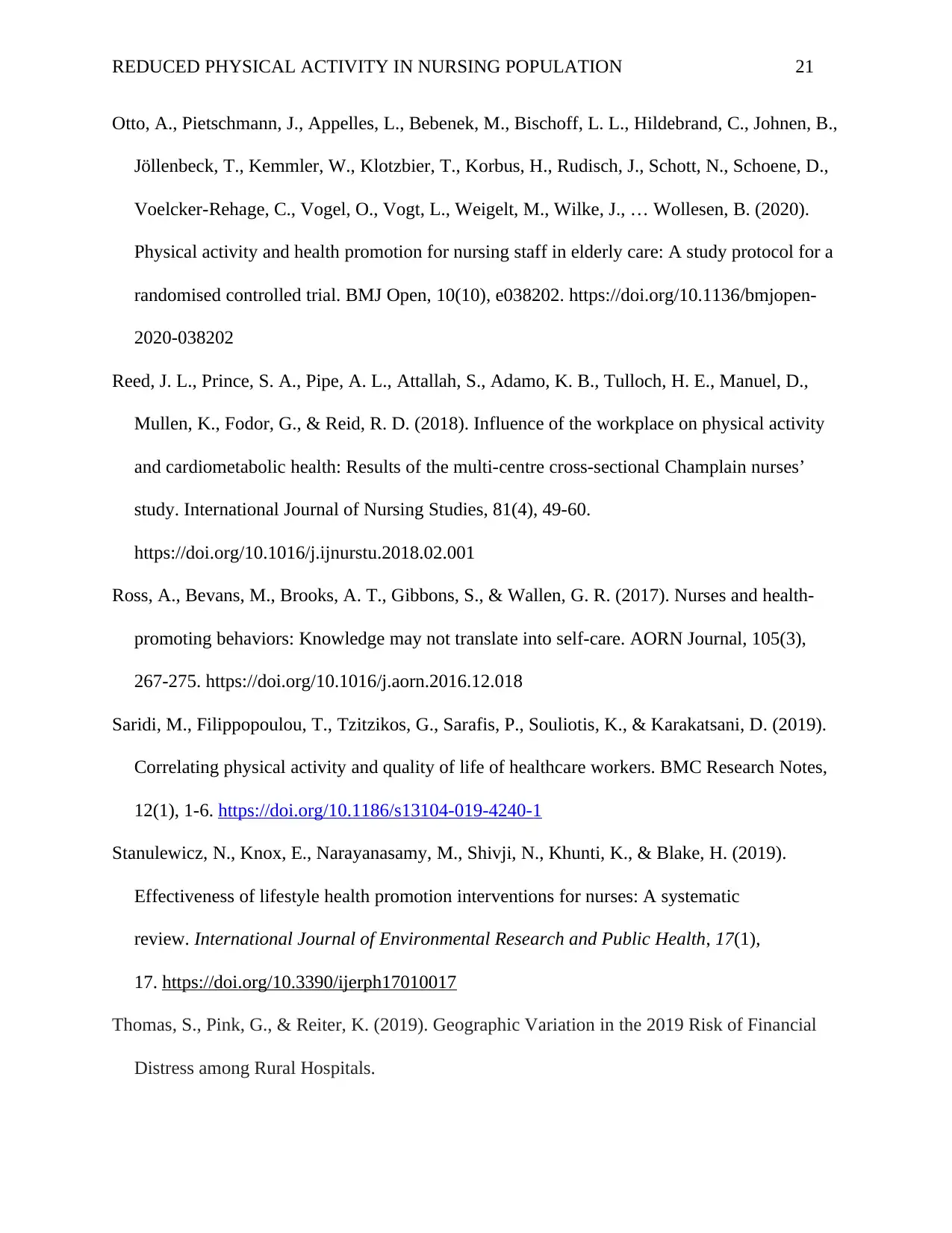
REDUCED PHYSICAL ACTIVITY IN NURSING POPULATION 21
Otto, A., Pietschmann, J., Appelles, L., Bebenek, M., Bischoff, L. L., Hildebrand, C., Johnen, B.,
Jöllenbeck, T., Kemmler, W., Klotzbier, T., Korbus, H., Rudisch, J., Schott, N., Schoene, D.,
Voelcker-Rehage, C., Vogel, O., Vogt, L., Weigelt, M., Wilke, J., … Wollesen, B. (2020).
Physical activity and health promotion for nursing staff in elderly care: A study protocol for a
randomised controlled trial. BMJ Open, 10(10), e038202. https://doi.org/10.1136/bmjopen-
2020-038202
Reed, J. L., Prince, S. A., Pipe, A. L., Attallah, S., Adamo, K. B., Tulloch, H. E., Manuel, D.,
Mullen, K., Fodor, G., & Reid, R. D. (2018). Influence of the workplace on physical activity
and cardiometabolic health: Results of the multi-centre cross-sectional Champlain nurses’
study. International Journal of Nursing Studies, 81(4), 49-60.
https://doi.org/10.1016/j.ijnurstu.2018.02.001
Ross, A., Bevans, M., Brooks, A. T., Gibbons, S., & Wallen, G. R. (2017). Nurses and health-
promoting behaviors: Knowledge may not translate into self-care. AORN Journal, 105(3),
267-275. https://doi.org/10.1016/j.aorn.2016.12.018
Saridi, M., Filippopoulou, T., Tzitzikos, G., Sarafis, P., Souliotis, K., & Karakatsani, D. (2019).
Correlating physical activity and quality of life of healthcare workers. BMC Research Notes,
12(1), 1-6. https://doi.org/10.1186/s13104-019-4240-1
Stanulewicz, N., Knox, E., Narayanasamy, M., Shivji, N., Khunti, K., & Blake, H. (2019).
Effectiveness of lifestyle health promotion interventions for nurses: A systematic
review. International Journal of Environmental Research and Public Health, 17(1),
17. https://doi.org/10.3390/ijerph17010017
Thomas, S., Pink, G., & Reiter, K. (2019). Geographic Variation in the 2019 Risk of Financial
Distress among Rural Hospitals.
Otto, A., Pietschmann, J., Appelles, L., Bebenek, M., Bischoff, L. L., Hildebrand, C., Johnen, B.,
Jöllenbeck, T., Kemmler, W., Klotzbier, T., Korbus, H., Rudisch, J., Schott, N., Schoene, D.,
Voelcker-Rehage, C., Vogel, O., Vogt, L., Weigelt, M., Wilke, J., … Wollesen, B. (2020).
Physical activity and health promotion for nursing staff in elderly care: A study protocol for a
randomised controlled trial. BMJ Open, 10(10), e038202. https://doi.org/10.1136/bmjopen-
2020-038202
Reed, J. L., Prince, S. A., Pipe, A. L., Attallah, S., Adamo, K. B., Tulloch, H. E., Manuel, D.,
Mullen, K., Fodor, G., & Reid, R. D. (2018). Influence of the workplace on physical activity
and cardiometabolic health: Results of the multi-centre cross-sectional Champlain nurses’
study. International Journal of Nursing Studies, 81(4), 49-60.
https://doi.org/10.1016/j.ijnurstu.2018.02.001
Ross, A., Bevans, M., Brooks, A. T., Gibbons, S., & Wallen, G. R. (2017). Nurses and health-
promoting behaviors: Knowledge may not translate into self-care. AORN Journal, 105(3),
267-275. https://doi.org/10.1016/j.aorn.2016.12.018
Saridi, M., Filippopoulou, T., Tzitzikos, G., Sarafis, P., Souliotis, K., & Karakatsani, D. (2019).
Correlating physical activity and quality of life of healthcare workers. BMC Research Notes,
12(1), 1-6. https://doi.org/10.1186/s13104-019-4240-1
Stanulewicz, N., Knox, E., Narayanasamy, M., Shivji, N., Khunti, K., & Blake, H. (2019).
Effectiveness of lifestyle health promotion interventions for nurses: A systematic
review. International Journal of Environmental Research and Public Health, 17(1),
17. https://doi.org/10.3390/ijerph17010017
Thomas, S., Pink, G., & Reiter, K. (2019). Geographic Variation in the 2019 Risk of Financial
Distress among Rural Hospitals.
You're viewing a preview
Unlock full access by subscribing today!
1 out of 21
Related Documents
Your All-in-One AI-Powered Toolkit for Academic Success.
+13062052269
info@desklib.com
Available 24*7 on WhatsApp / Email
![[object Object]](/_next/static/media/star-bottom.7253800d.svg)
Unlock your academic potential
© 2024 | Zucol Services PVT LTD | All rights reserved.




